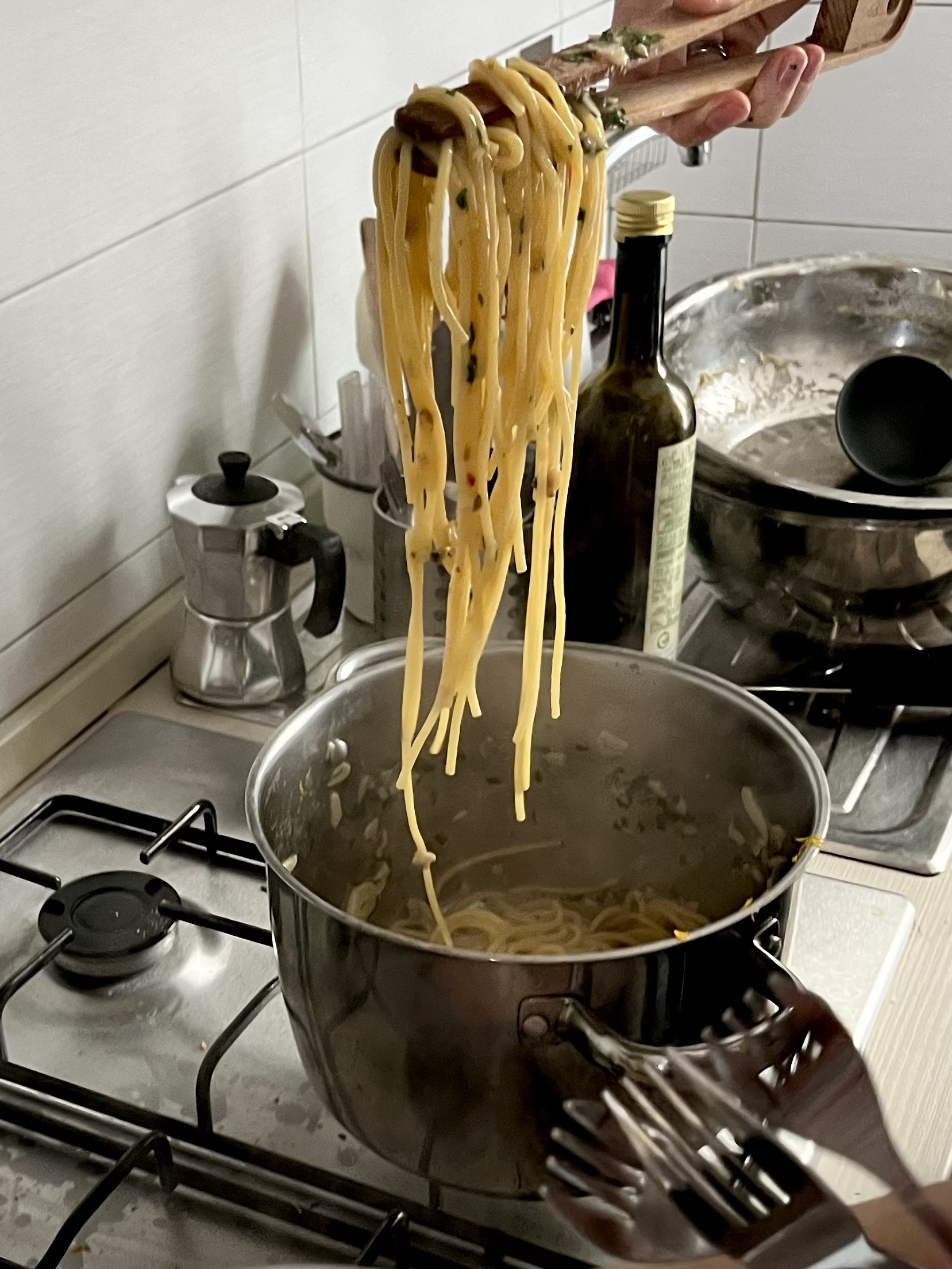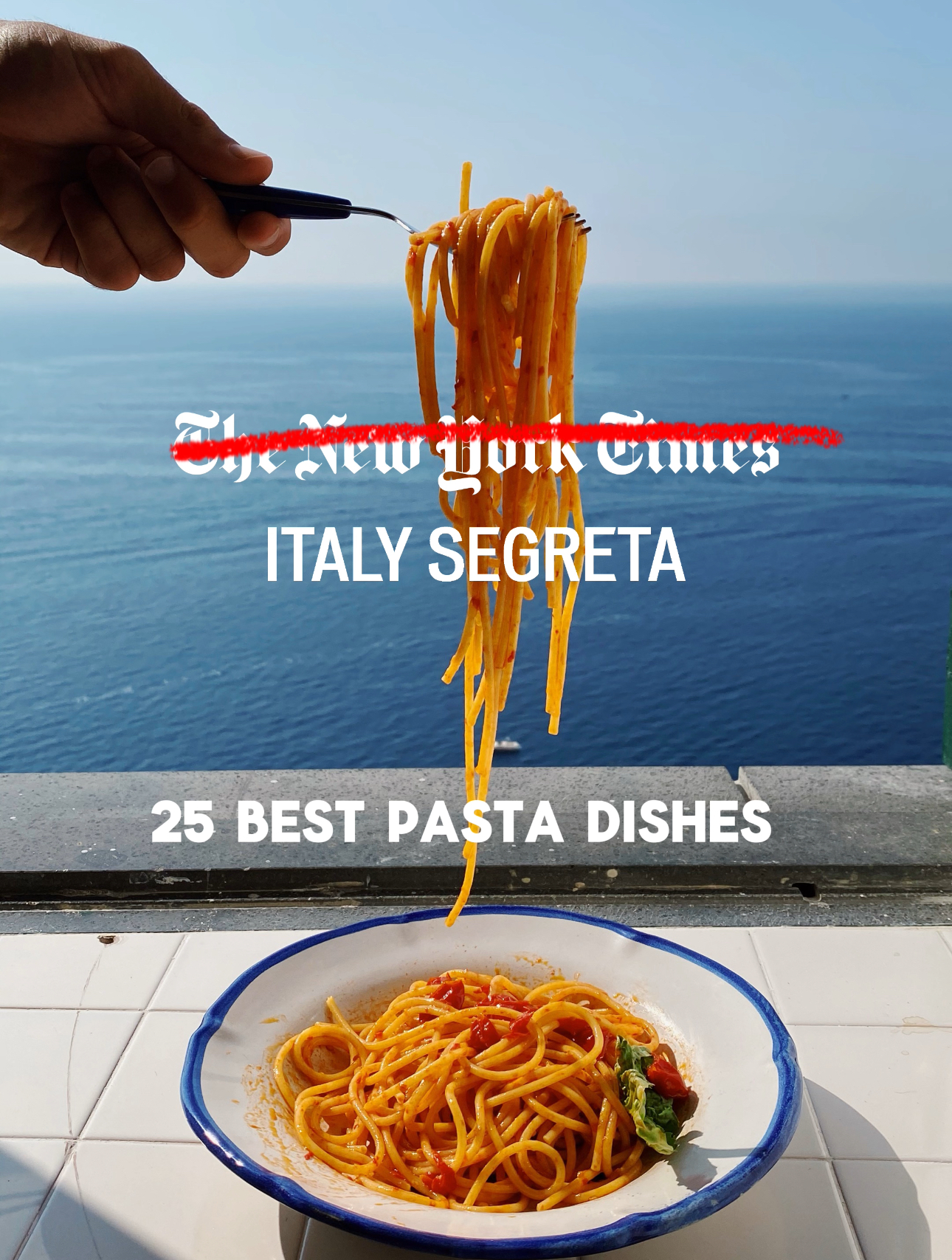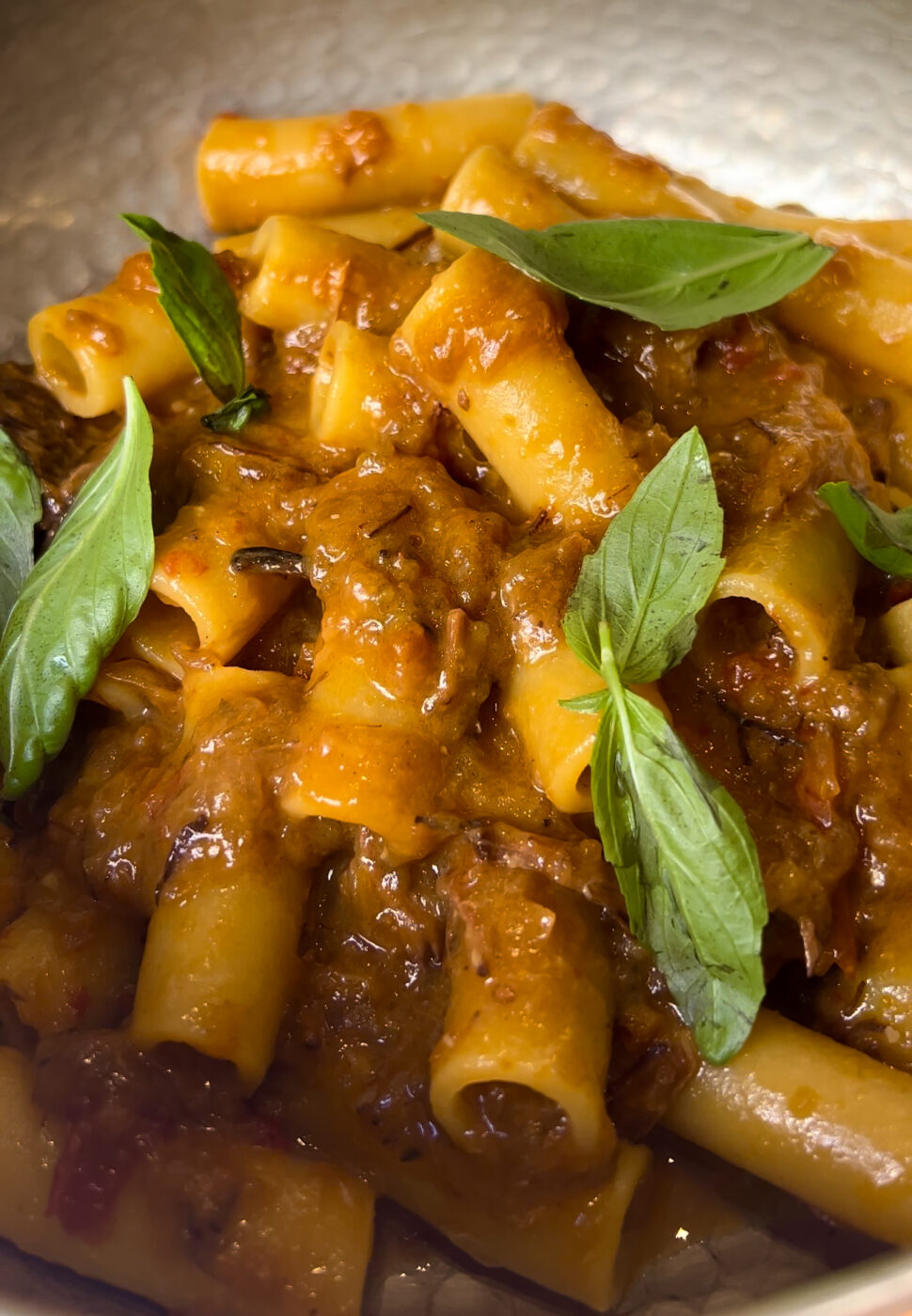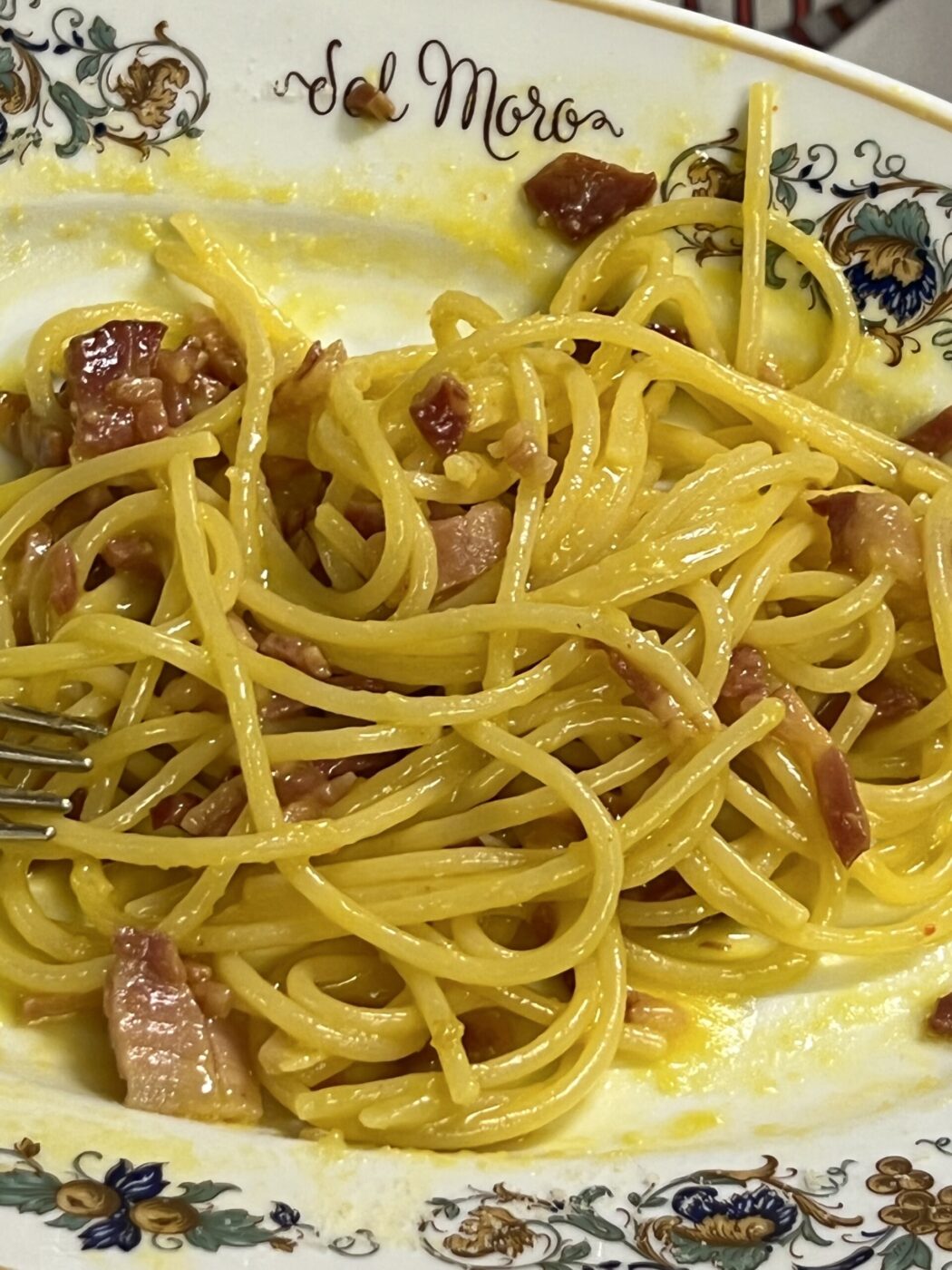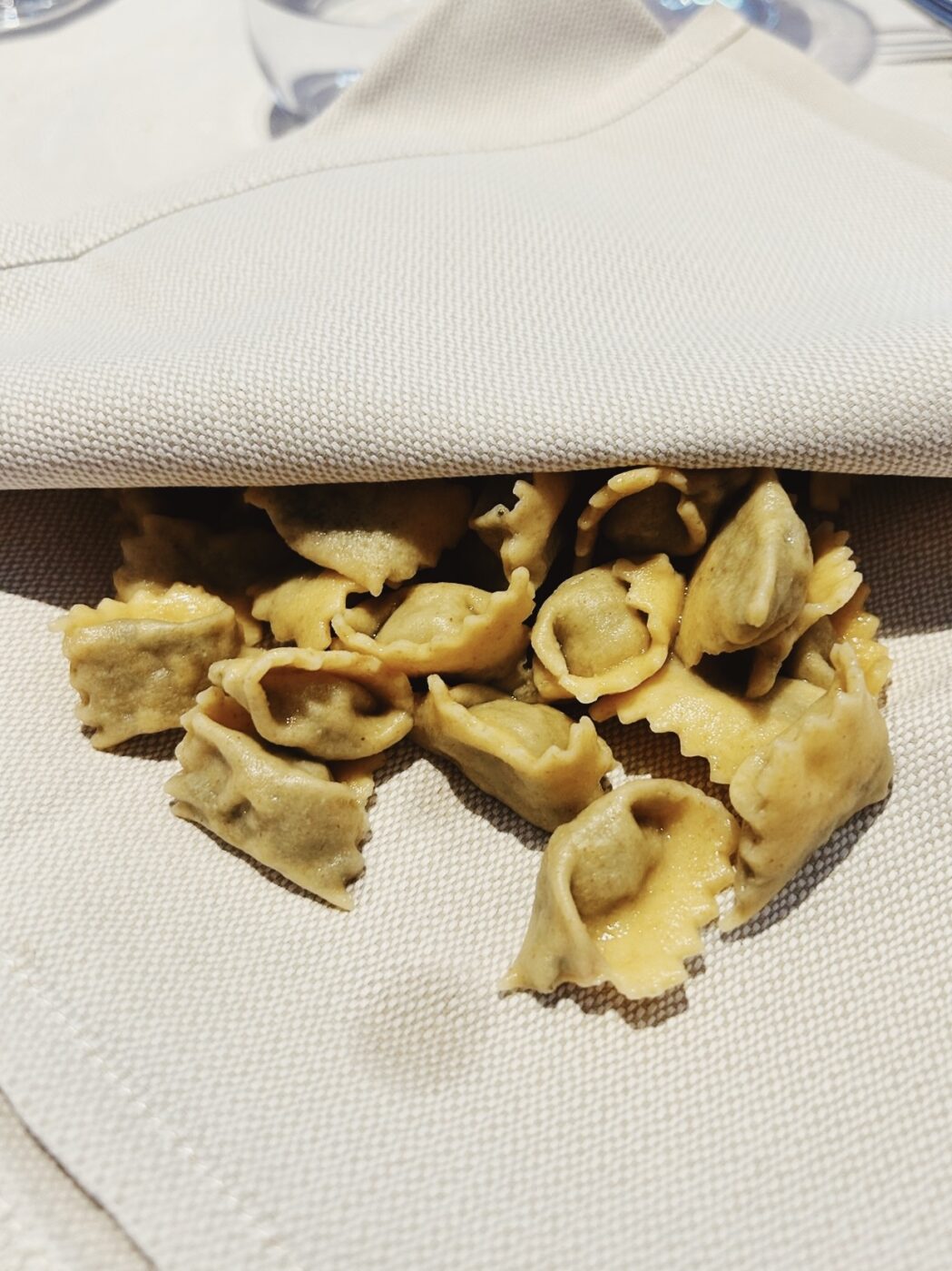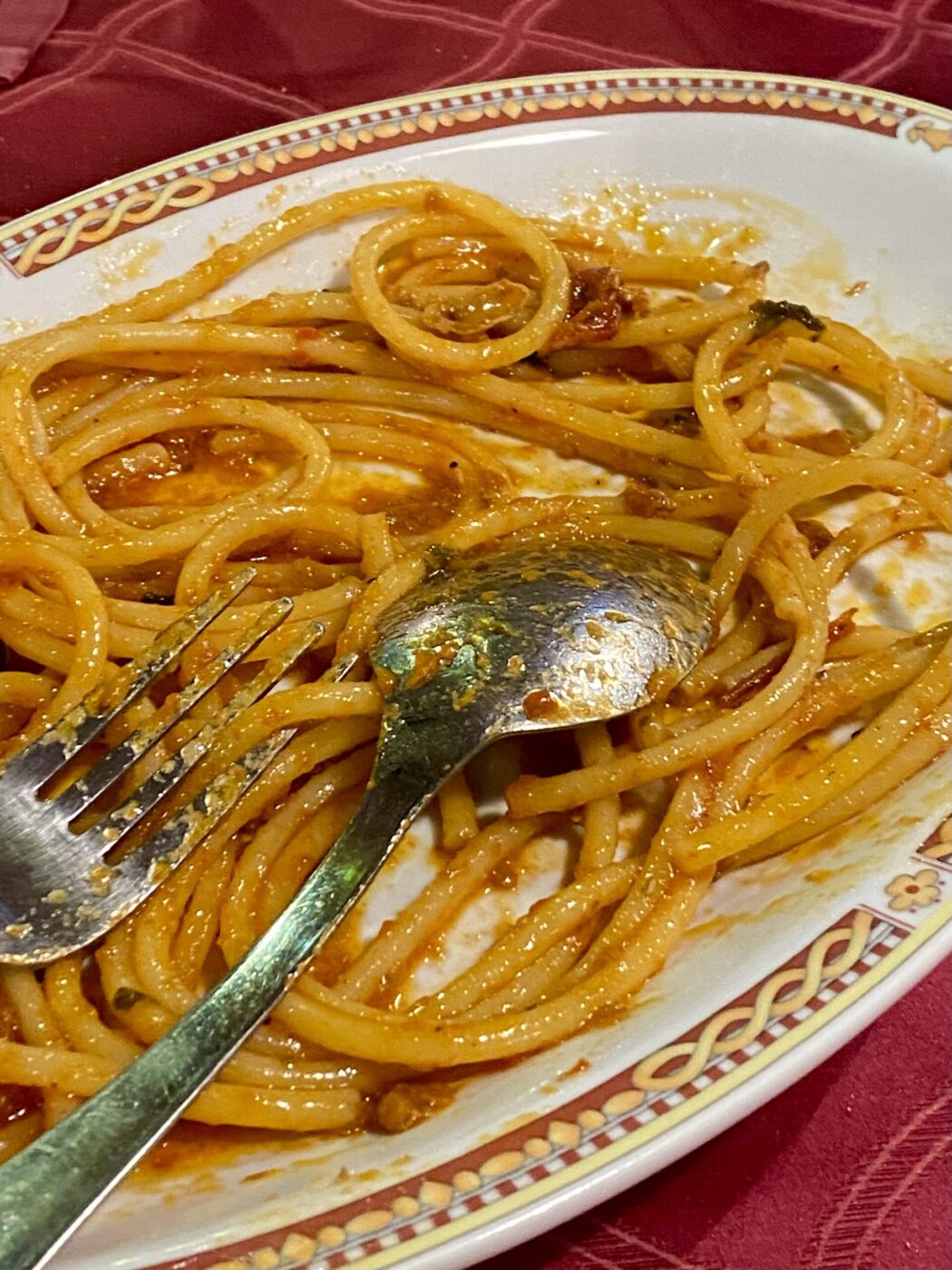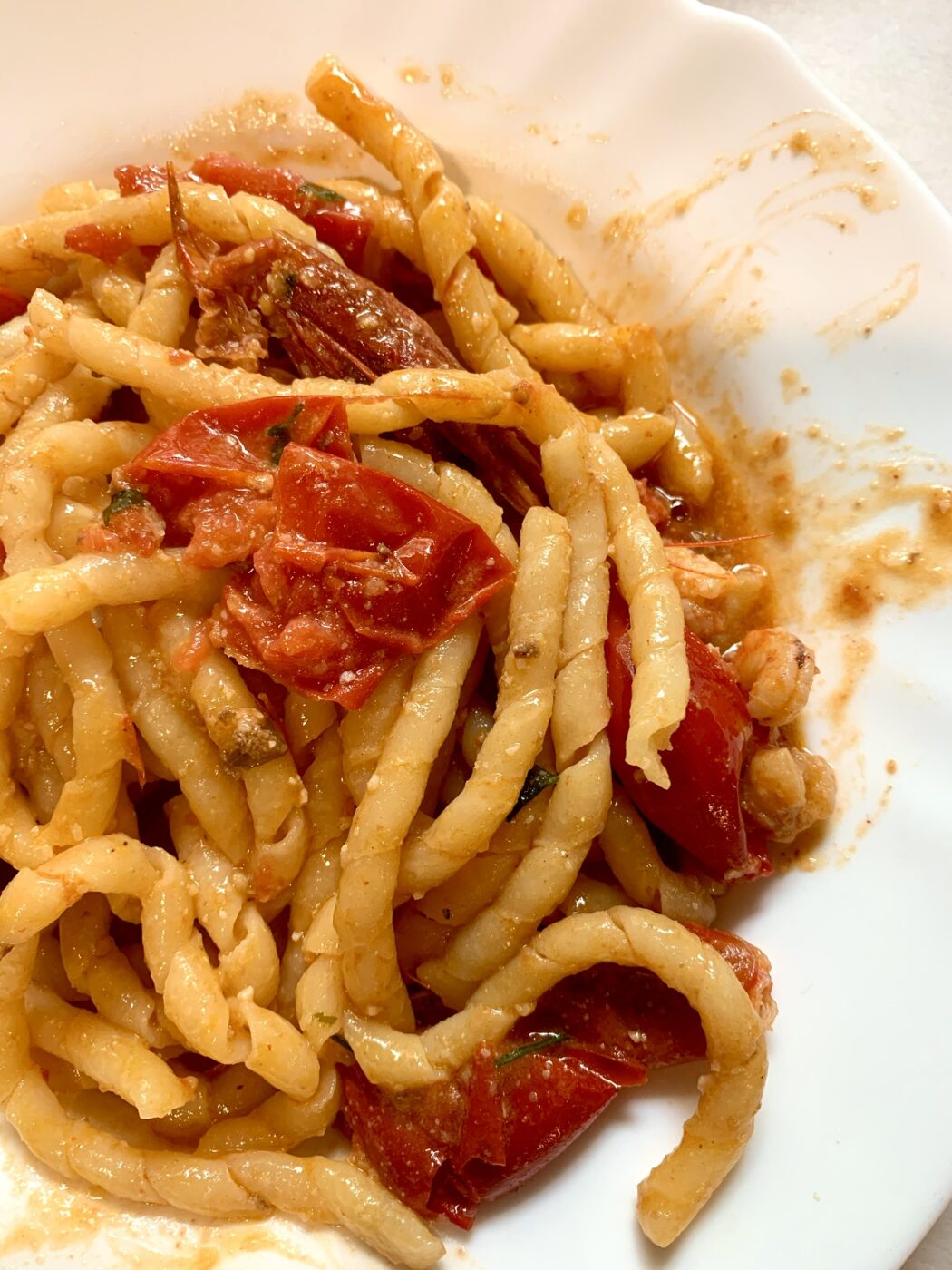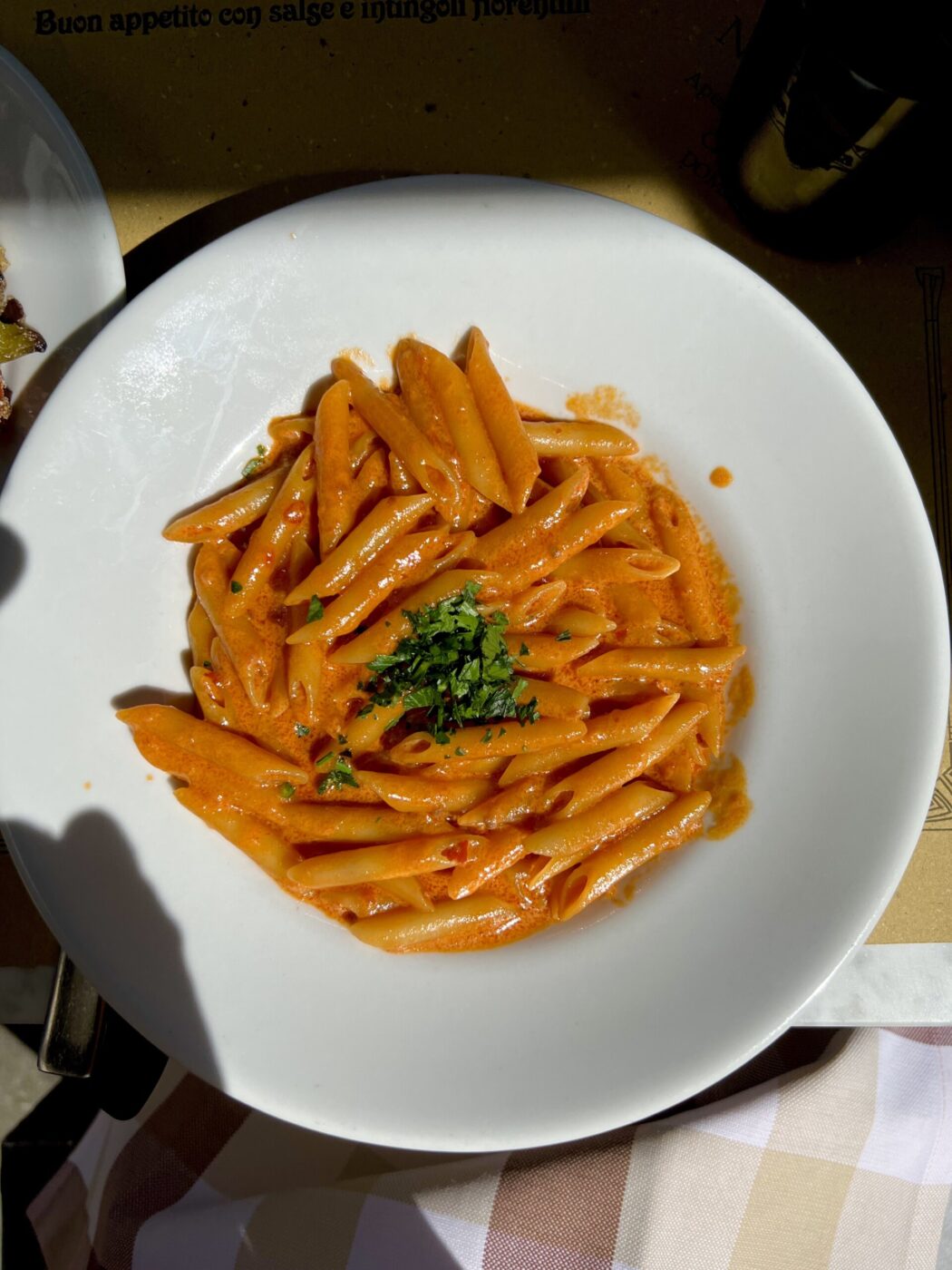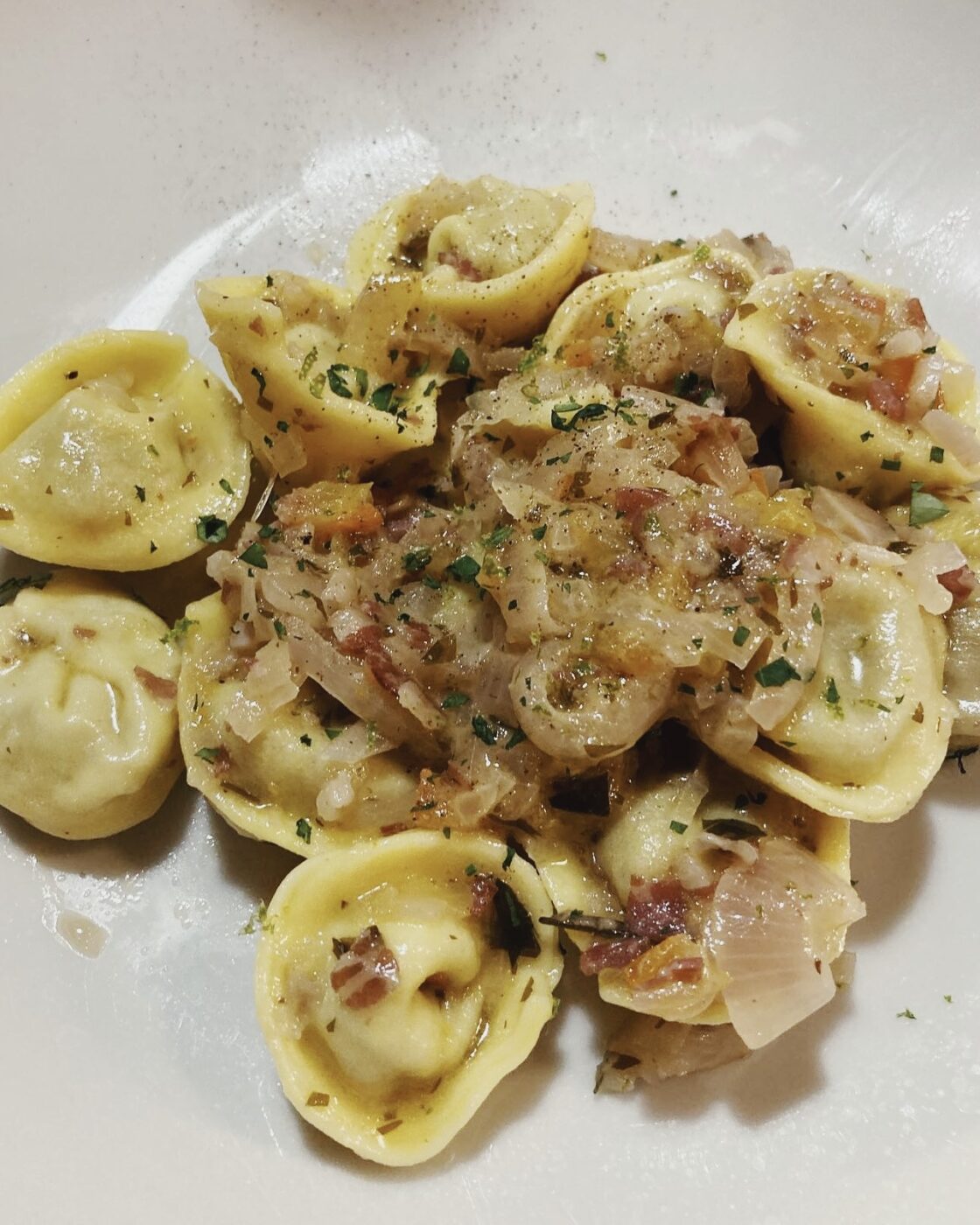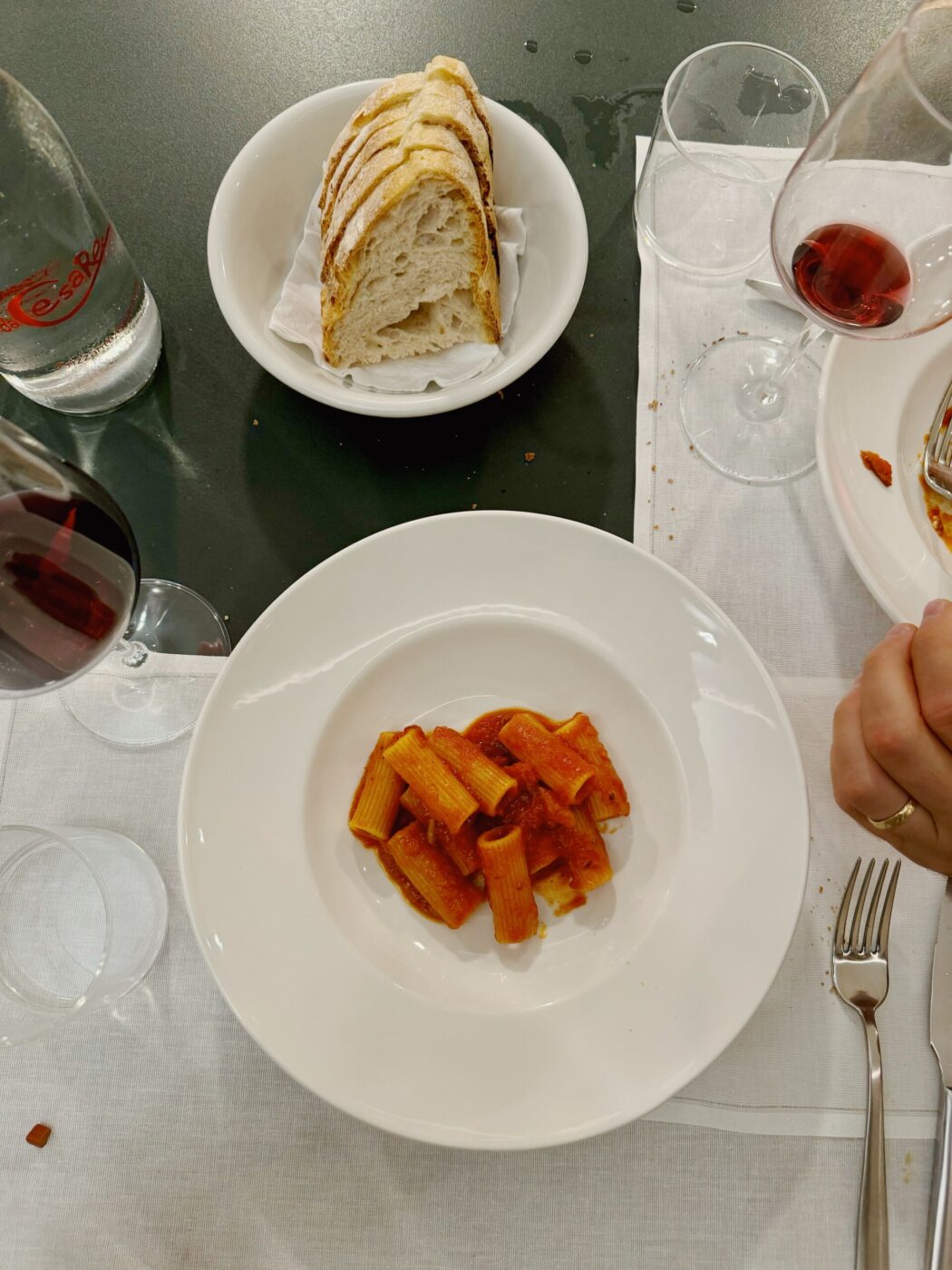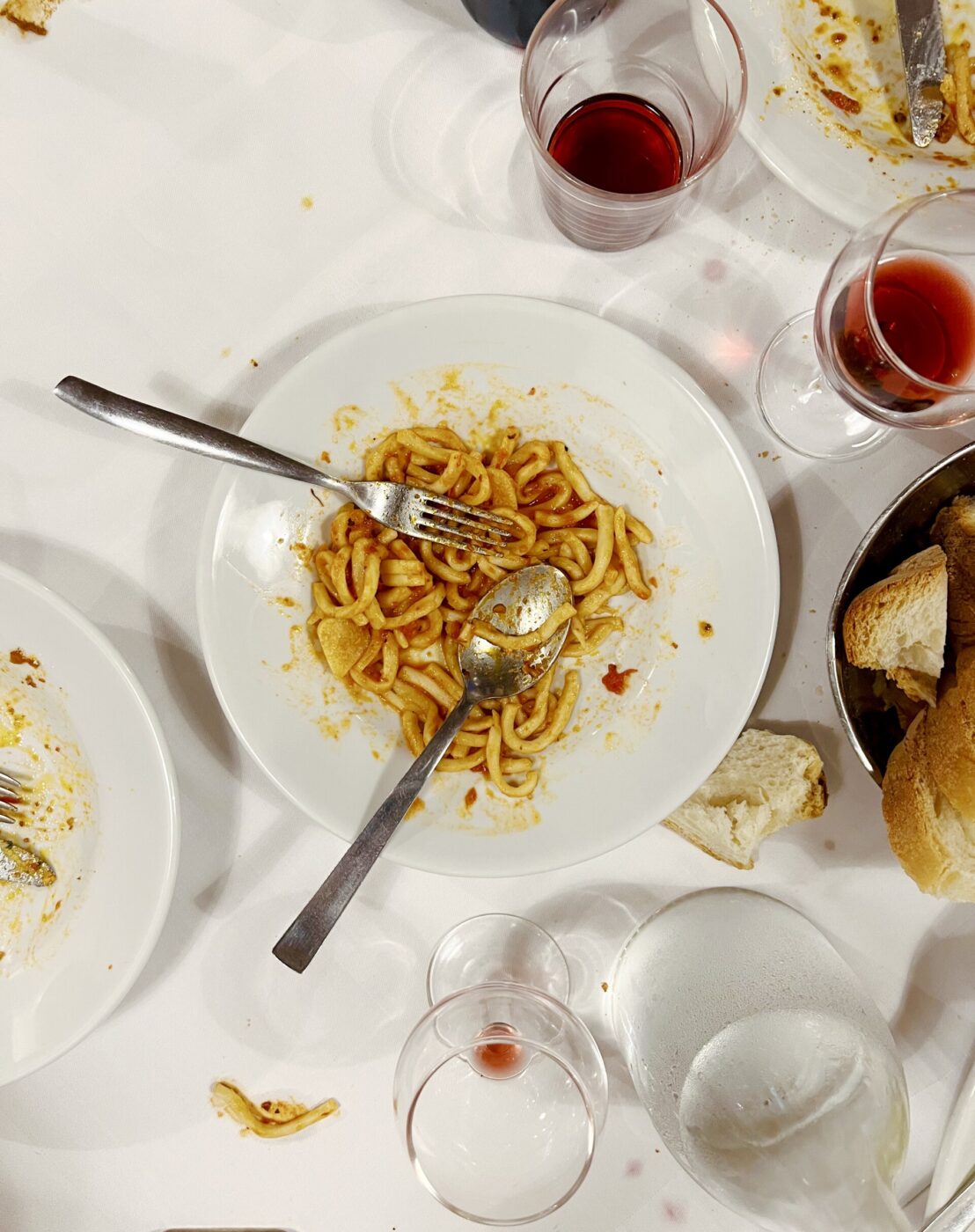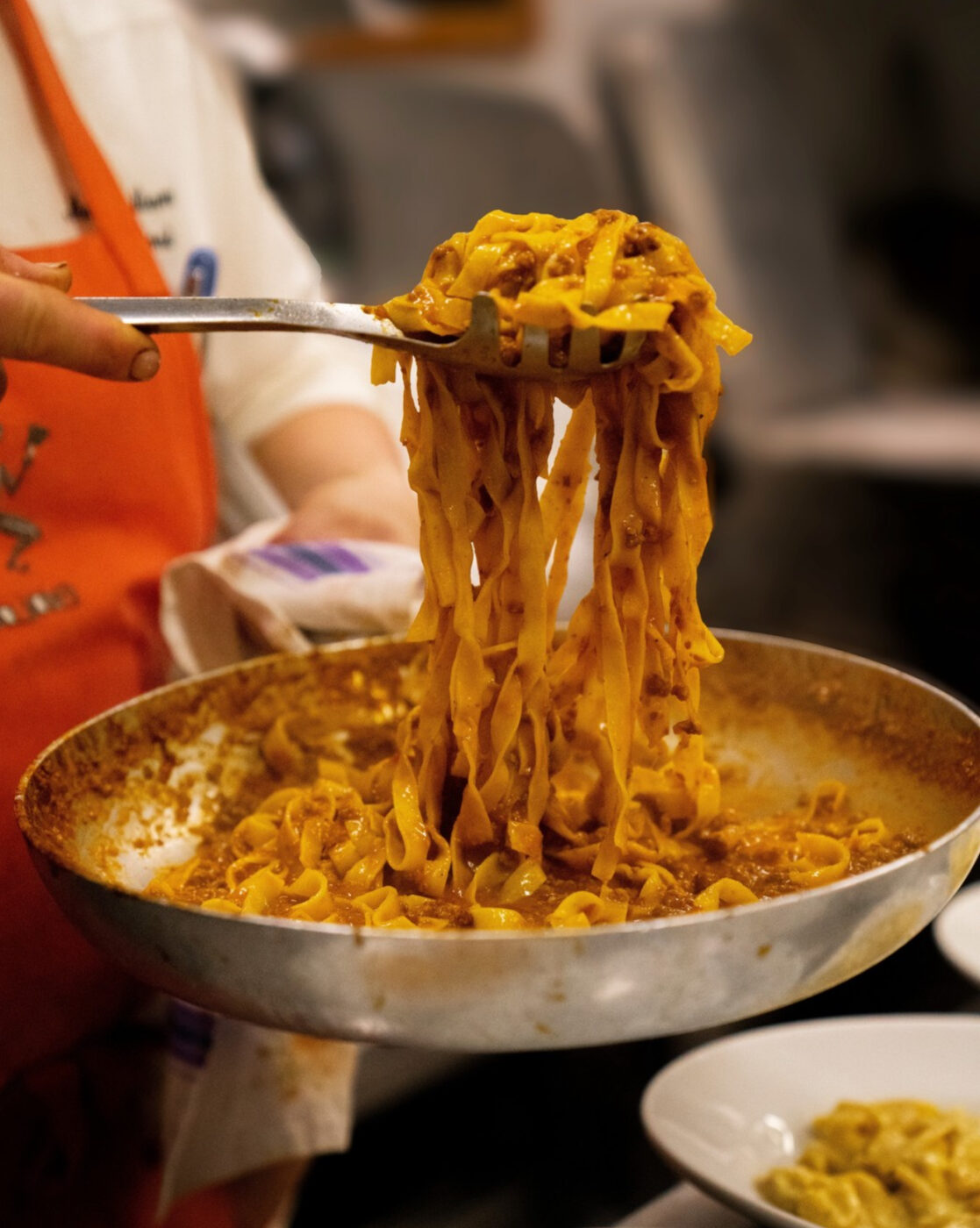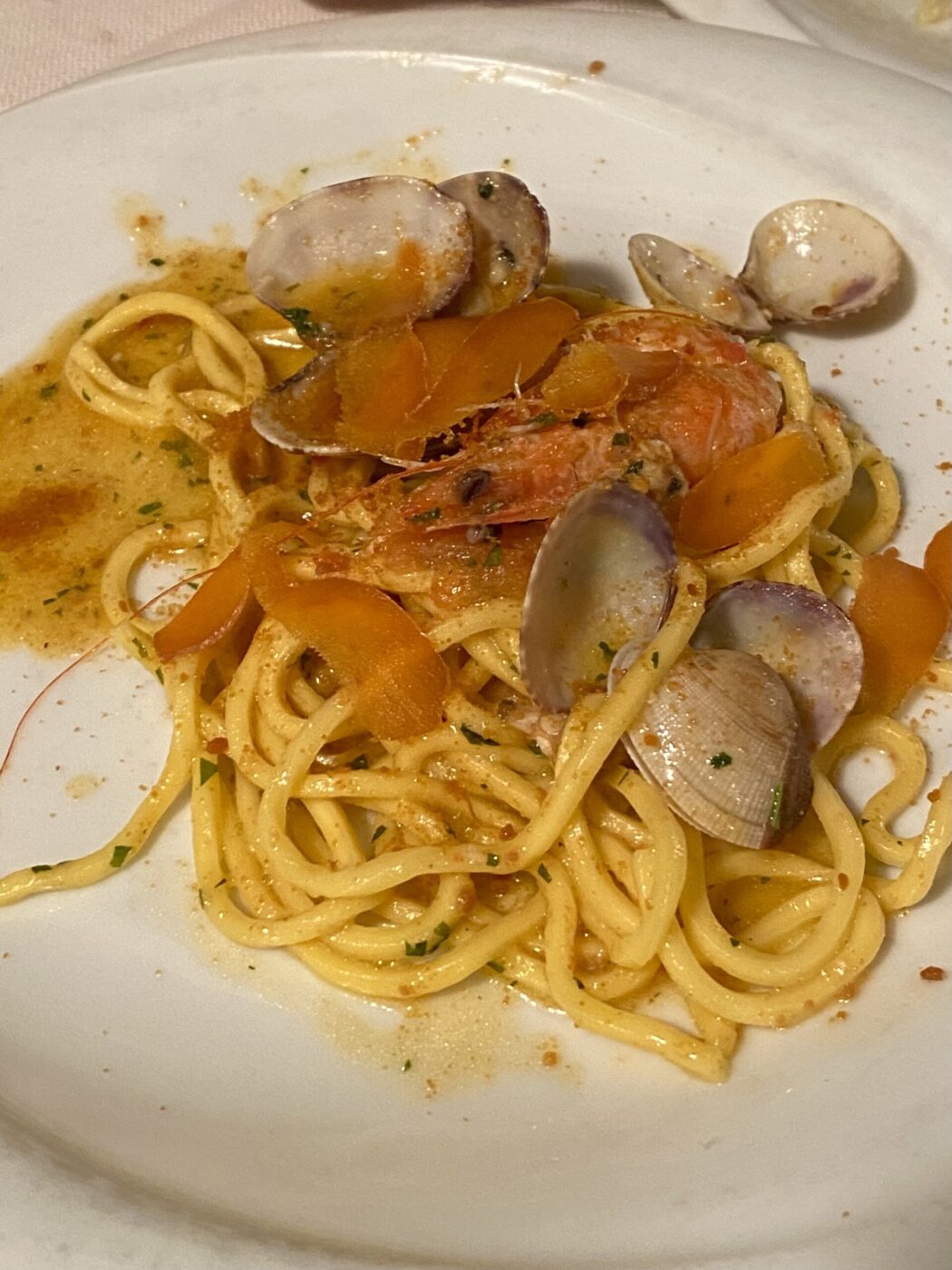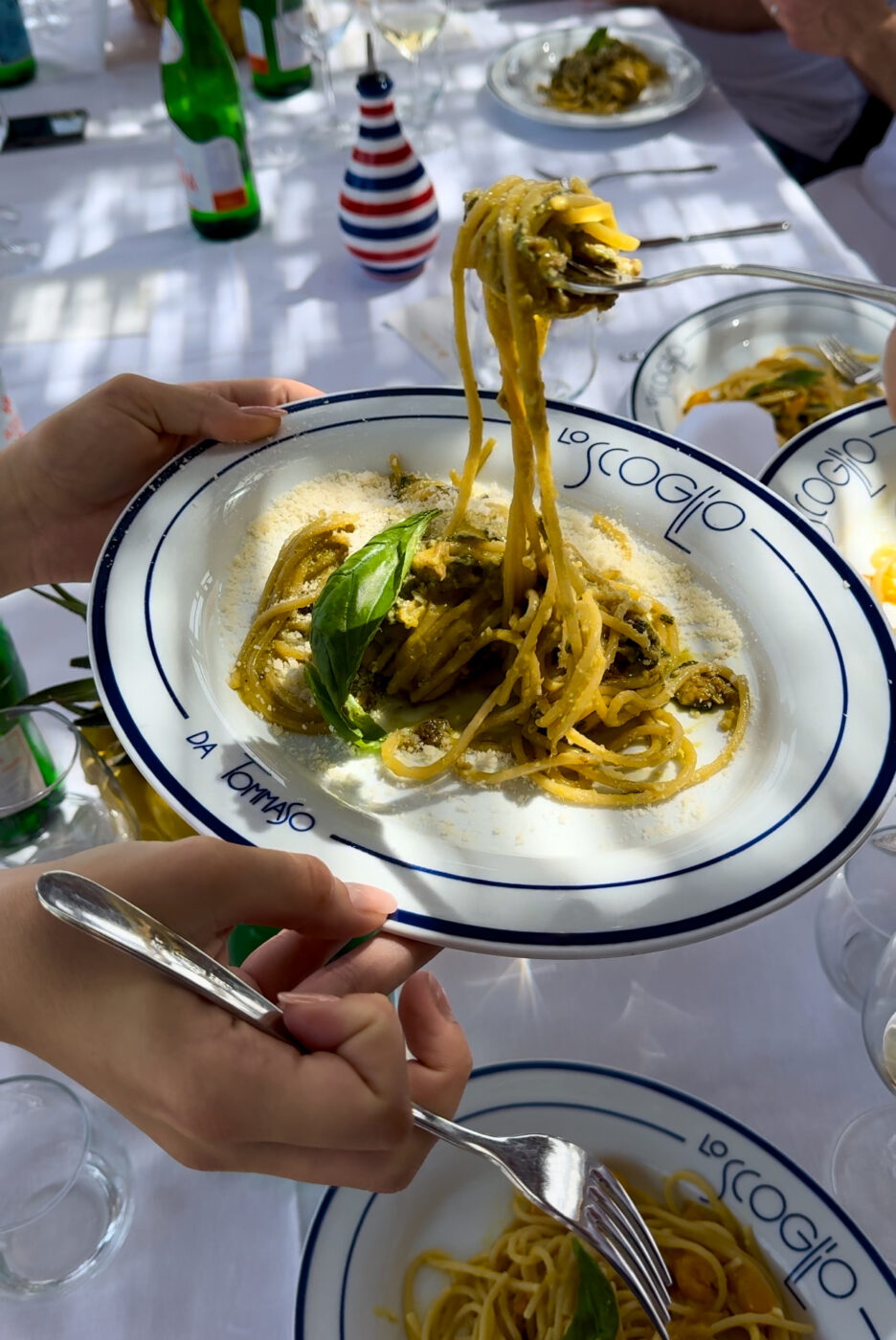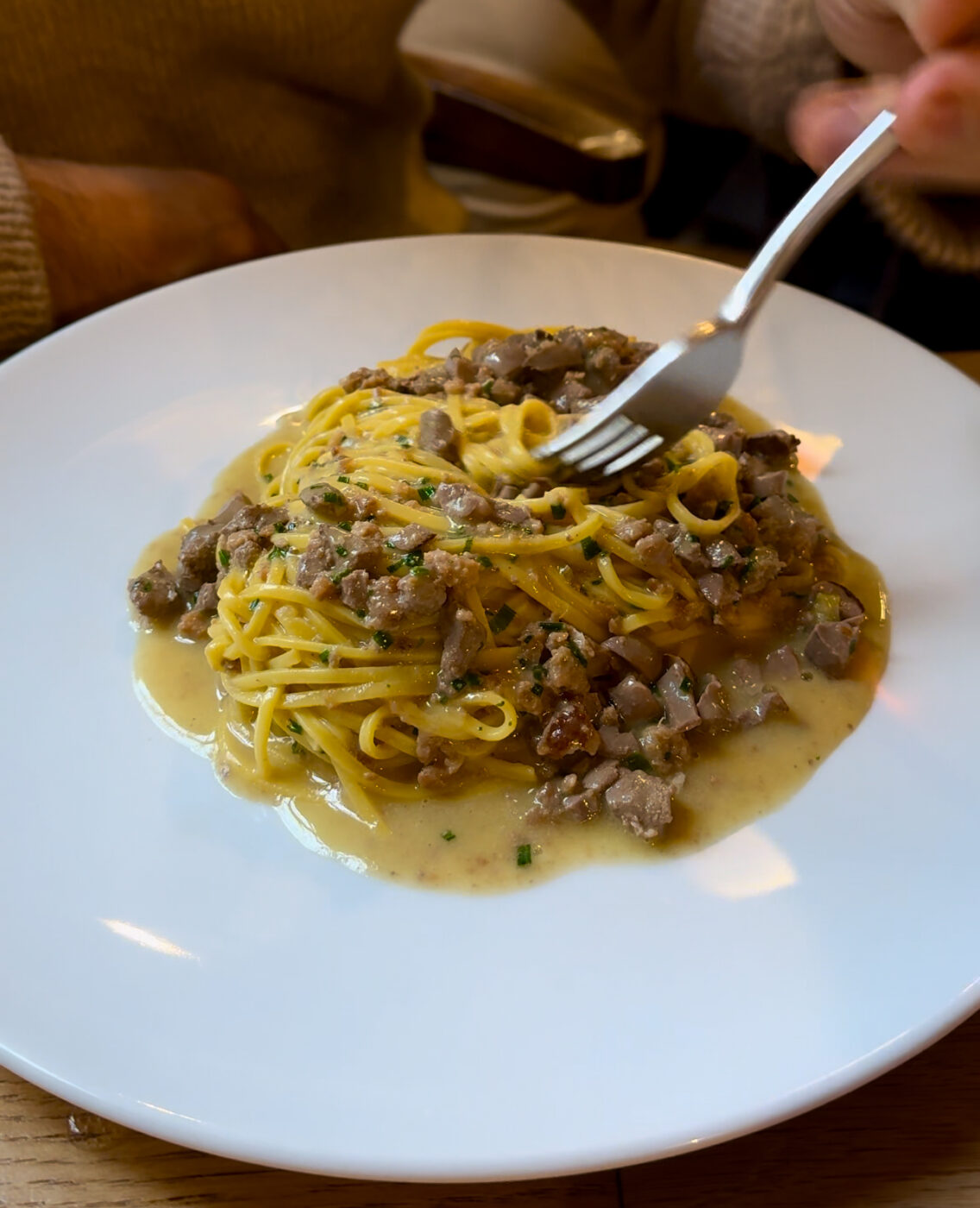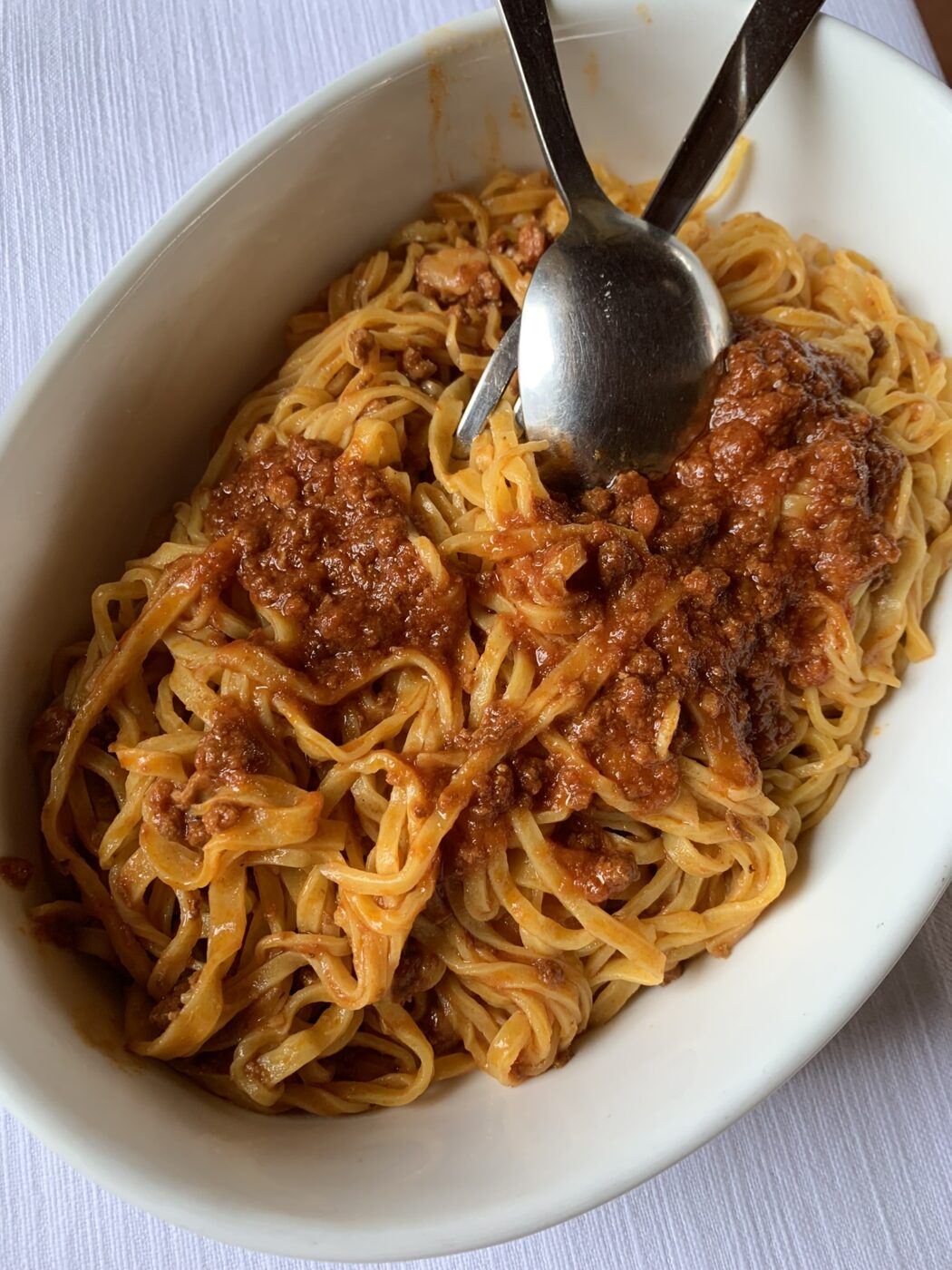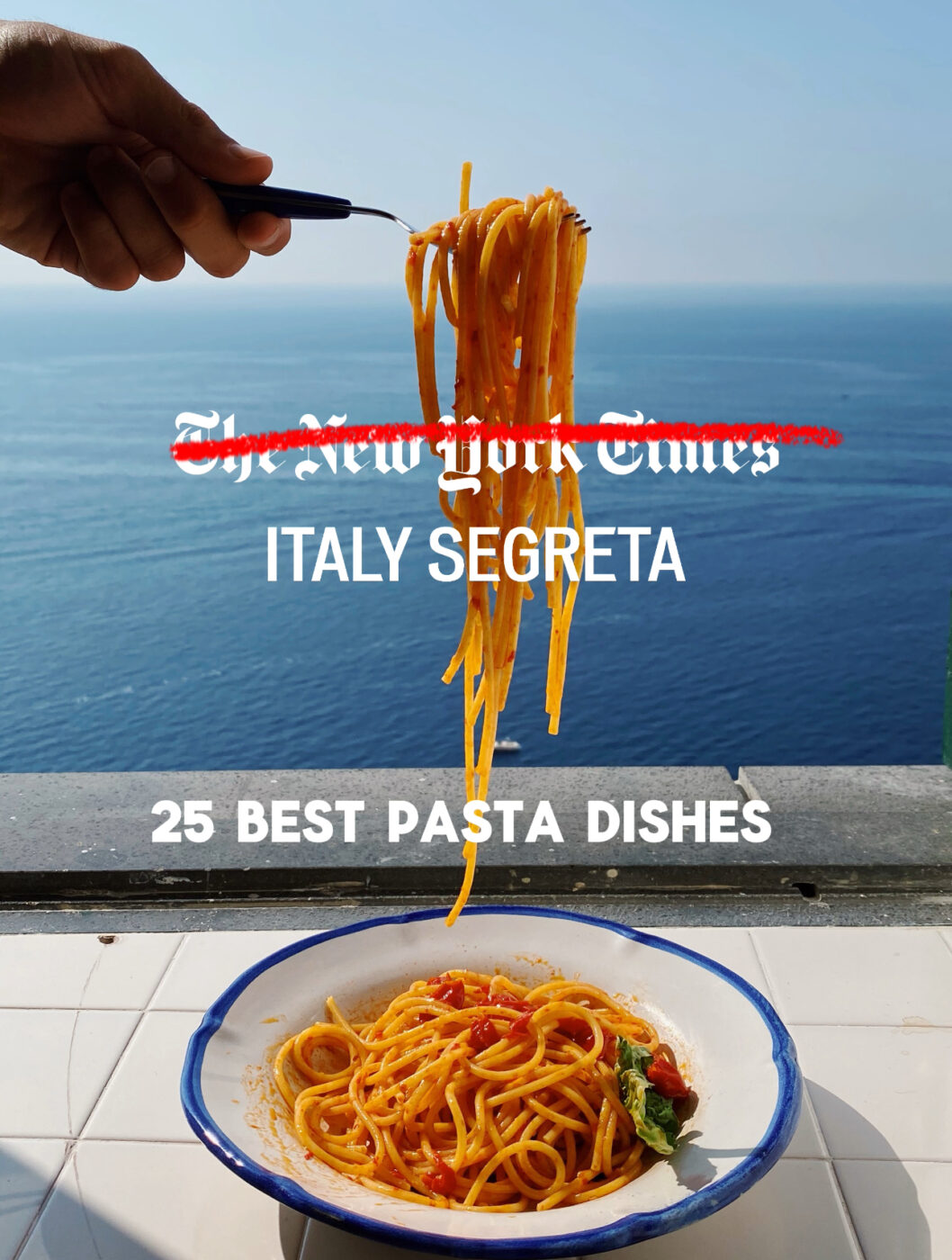Recently, The New York Times came out with an article titled “The 25 Essential Pasta Dishes to Eat in Italy”. We see you, we love you, and we respect you (and your team of panelists), but frankly, a lot of the choices were just too ~Michelin for our tastes–and so we present to you our essential pastas. While it does seem like an impossible feat to narrow down the country’s infinite amount of pasta dishes to just 25, there are some that we, as a team with all different palates and based across the boot, keep coming back to over and over again.
Pasta is, as NYT wrote, “just flour, water or sometimes eggs,” but that makes it the perfect blank canvas. Historically, it was a food of southern Italy, the poorer half of the country, who would air dry the noodles in the salty sea breeze and top it with any cheap ingredient they could get their hands on. You might’ve heard us talk about Italy’s cucina povera traditions, and there’s almost nothing that applies to this more than pasta. Rome’s famed carbonara was born from the need to use the unappealing guanciale that was often a form of payment for workers at Testaccio’s slaughterhouse; a little bit of cheese and thin eggy pasta in the form of agnolotti or tortellini can make any cuts of meat seem better. Cheap and filling, it was not a food of the nobility. That’s why none of the dishes on our list will run you over €23 (and most clock in well below), as opposed to some of the chi-chi restaurants on NYT’s list.
Pasta is at its best when it’s made simply and with local ingredients; it’s not about the fuss and the wine pairings, but the history of the dish, the flavors of the region, and the spirit put into it. So, this list is not just of the most mouthwatering pastas from Italy, but of the people and places that make us feel a certain way.
The dishes are listed below in unranked order. Please excuse that our photos aren’t as glossy and appetizing as those of the NYT; what we managed to capture are iPhone shots taken in the brief seconds between the pasta plate hitting the table and us devouring it.
Candele alla Genovese at Mimi alla Ferrovia
Naples, Campania
Though the name means the “girl from Genova”, this sauce is entirely Neapolitan, with a sweet, deep flavor thanks to slow, slow cooking and a mountain of thinly sliced Ramata Di Montoro Onions. The tomato-less recipe stands apart from the city’s usual culinary canon, but you don’t miss it with the combo of onions plus three different cuts of beef and guanciale. Mimi Alla Ferrovia, a Neapolitan staple since 1943, serves our favorite version of the sauce on smooth candele (longer ziti), topped with a shaving of parm and fresh basil. Here, the owner and his son, chef Salvatore Giugliano (known as Sasà) welcome you as if you were old friends, invited to dinner over a deceptively delicious dish of candele.
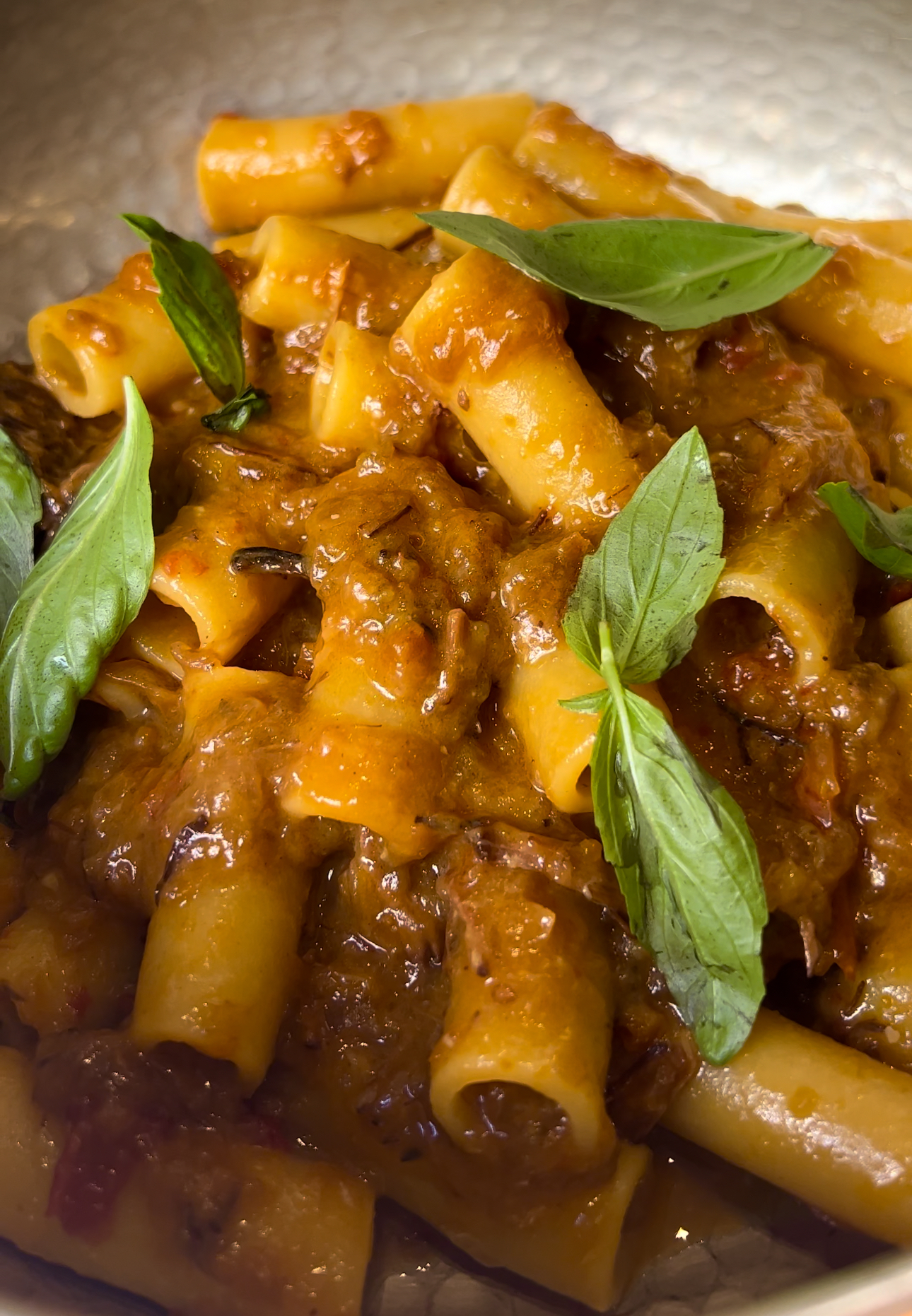
Spaghetti alla Moro at Trattoria Al Moro
Rome, Lazio
Spaghetti alla Moro is this Roman institution’s take on the city’s beloved carbonara, an extra creamy (creamless) pasta dish of eggs, pecorino, smoked guanciale, and peperoncino. Al Moro, around since the 1920s, serves superbly-executed plates in a wood-paneled space just around the corner from the Trevi Fountain, and they pair their carbonara with spaghetti, an unpopular choice amongst the city’s usual mezze maniche or rigatoni offerings. At €23, this is the most expensive dish on the list–the atmosphere leans towards the high-end, as do the prices–though the restaurant remains surprisingly unfussy. Come lunchtime, you’ll be dining on the pasta, springtime vignarola, and superlative zabaione side by side with politicians and lobbiers on their lunch breaks.
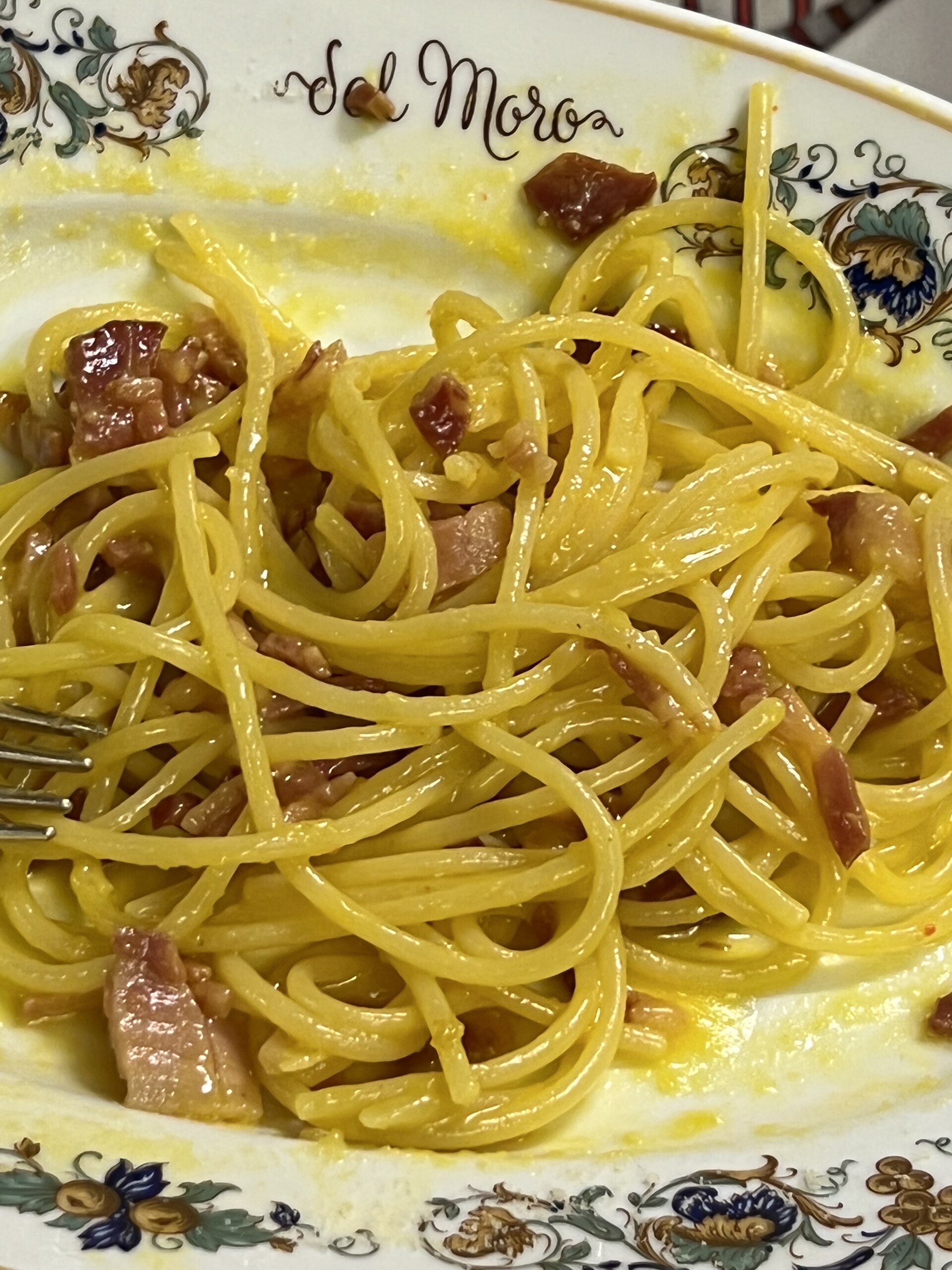
Struncatura Classica at Ristorante – Enoteca Donna Nela in Polistena
Reggio Calabria, Calabria
Struncatura, in the Calabrese dialect, is a type of pasta made with semolina that’s similar to a whole wheat linguine. It’s a little chewy, pretty hearty, and made “Donna Nela” by getting tossed with passata, anchovies, peperoncino, black Chianote olives, Parmigiano, and breadcrumbs. Though it’s made with a few simple pantry ingredients, the result is something deeply umami, spicy, and texturally interesting (thanks to the breadcrumbs); no one does it better than restaurant and wine shop Donna Nela, the passion project of duo Giampiero and Erika with a veritable showing of local cuisine and over 500 wine labels.
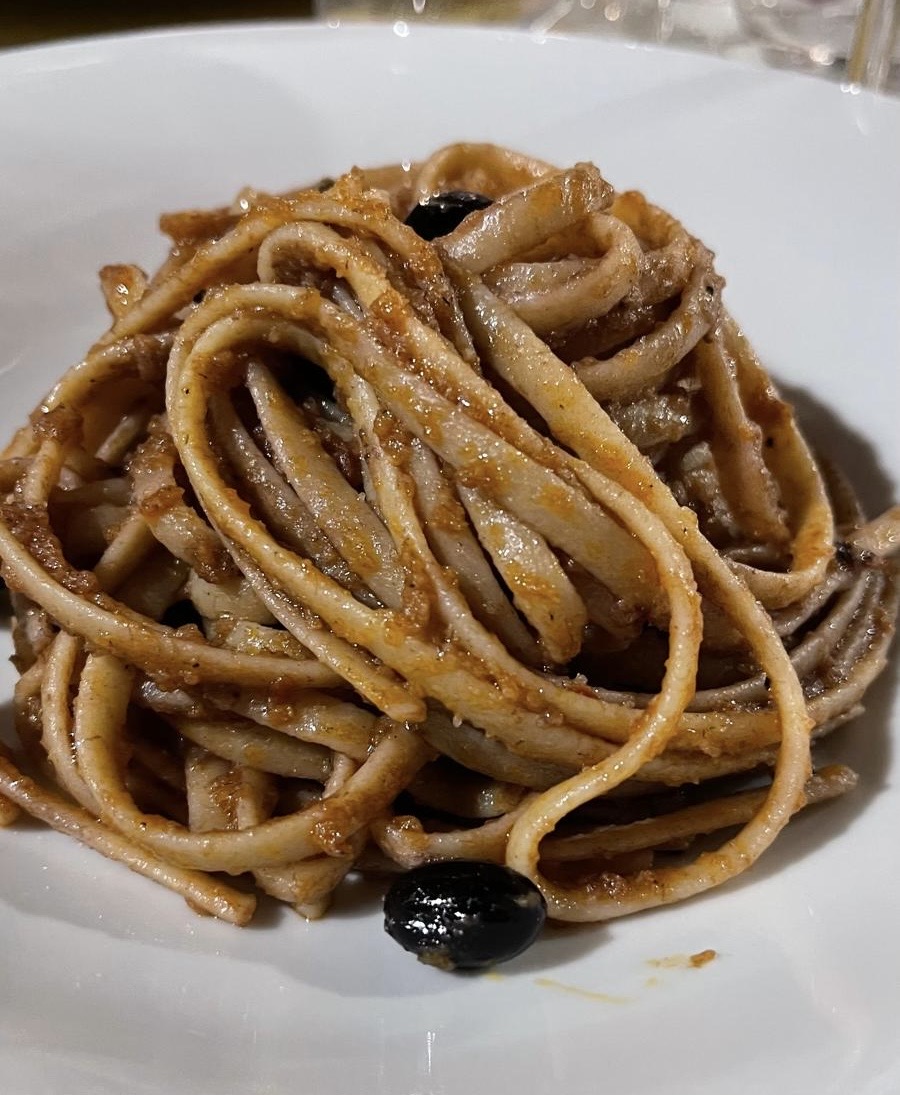
Agnolotti del Plin at Ristorante Battaglino dal 1919
Bra, Piedmont
Piedmont’s contribution to Italy’s stuffed pasta repertoire, agnolotti del plin is a fresh egg pasta filled with a mixture of minced veal and pork and usually parmesan and greens. They are pinched into little dumplings with a movement known as “plin” in the Piedmontese dialect. The tiny ravioli hail specifically from in and around the Langhe region and are flavorful enough to stand up to the area’s deep Barolo wines. Traditionally, they are served “al tovagliolo” (in a napkin) without any sauce, calling back to the way children would carry them to school for lunch. You can order them this way at Ristorante Battaglino dal 1919 in Bra, the birthplace of the Slow Food movement. You can also get them with a sauce of butter and sage, or, our personal favorite, with sugo d’arrosto, a rich sauce made from the drippings of a beef roast. For over 100 years (and across four generations), Battaglino has been a pinnacle of quality and traditional Piedmontese cuisine, but they haven’t let it trap them. Amongst the white tablecloths, salsiccia di Bra, and Nebbiolo wines, you’ll find veggie-forward dishes and some creative interpretations every now and again.
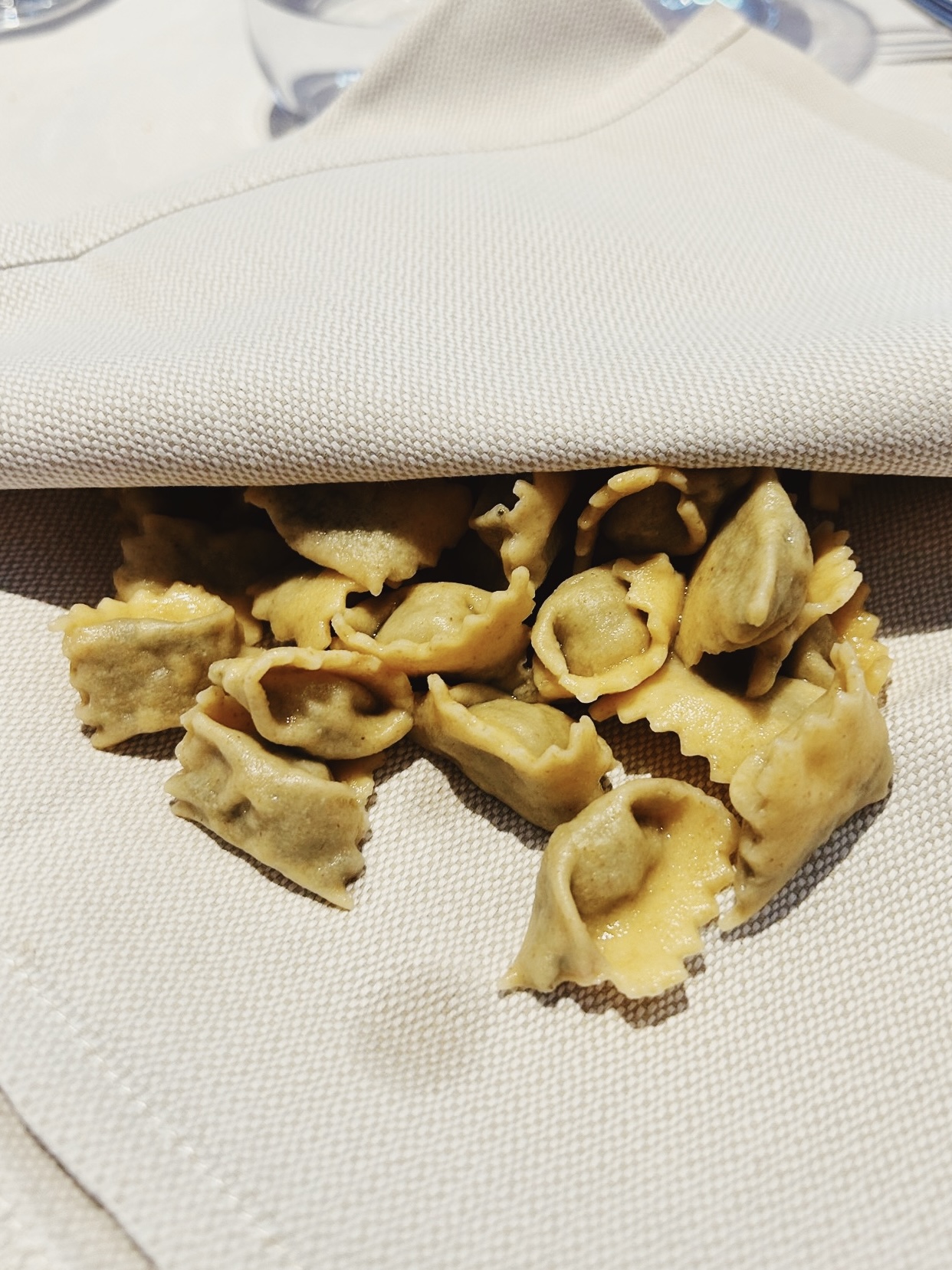
Agnolotti del Plin
Orecchiette con Cime di Rape at Osteria del Tempo Perso
Ostuni, Puglia
Made with just local durum wheat flour and water, the tiny concave scoops of pasta are perfect for capturing bits of the oily, garlicy sauce from the sautéed cime di rape, or broccoli rabe. The beauty of this combo is the balance: chewy orecchiette with the tender, nutty, and acrid cime di rape, lightly perfumed by garlic, anchovy, and peperoncino. Head to Osteria del Tempo Perso, built into an old forno, for our favorite in the region, best enjoyed inside the dimly lit, vibey, 16th century cave-turned-oven or, alternatively, in the bright-lit, modern, and adjoining revamped granary.

Bucatini al Coniglio at Ristorante Bracconiere
Isola d’Ischia, Campania
Yes, Ischia is an island, but the most famous pasta on this Campanian isle isn’t seafood, but bucatini al coniglio. During the Neapolitan Angevin dynasty from the 13th to 15th centuries, Ischia was used as a popular hunting ground, and rabbits were bred here for the sport. They were typically stewed and enjoyed on holidays or Sundays as a secondo, and the cooking juices and all the small bits that fell apart during cooking were transformed into the perfect ragù. Bucatini is the pasta of choice, a hearty noodle to stand up to the hearty sauce, while the rabbit is prepared with white wine, tomato, rosemary, garlic, basil, and olive oil, cooked slowly until the already tender meat becomes even more juicy. There’s nowhere better to eat it than the rustic Ristorante Bracconiere; large wooden tables, vintage photos and equipment on the walls, and a veranda boasting a view 500 meters down to the blue sea, it calls back to the old peasant houses of Ischia, where smells of bubbling rabbit floated out of the windows every Sunday.
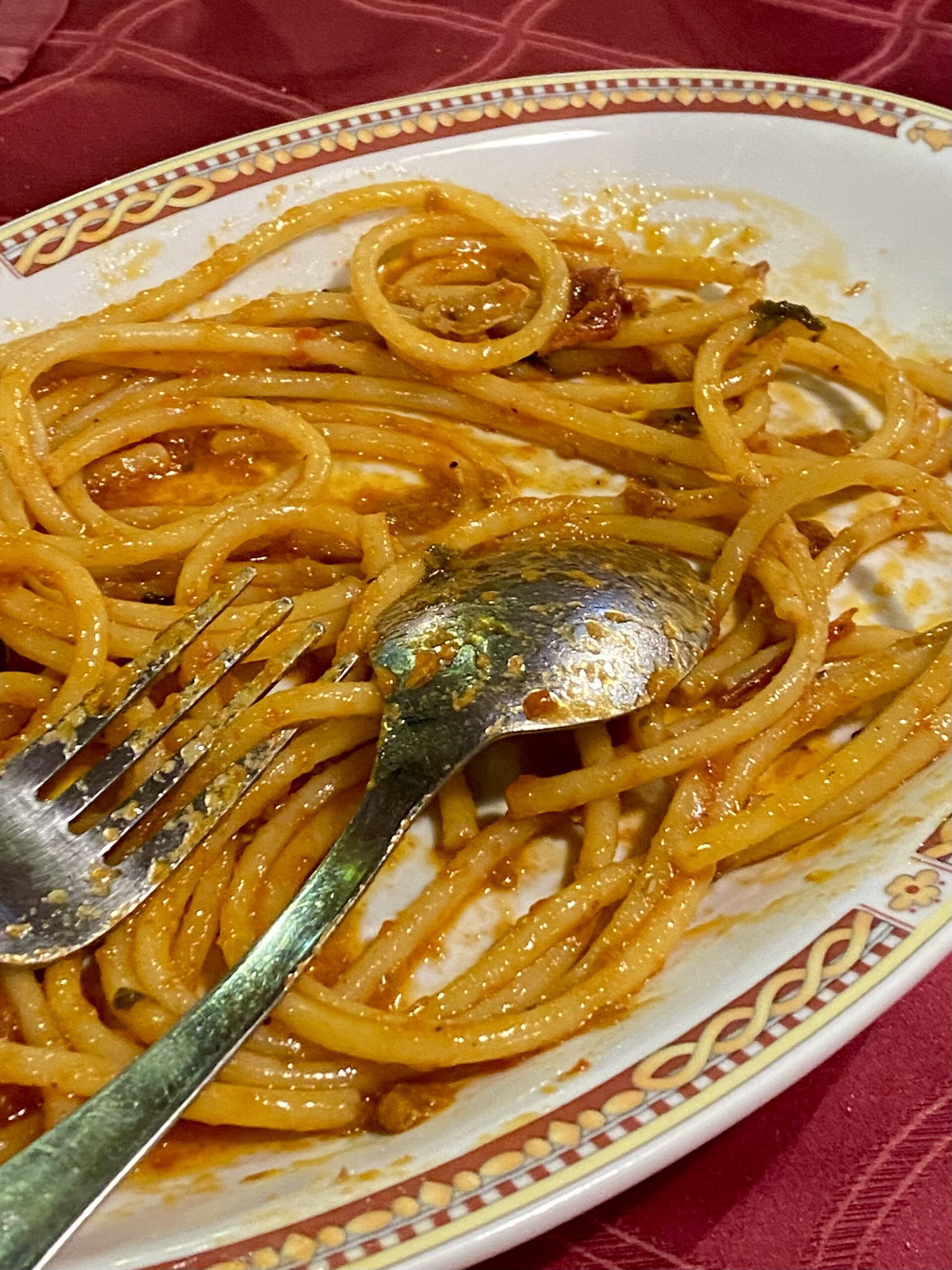
Spaghetti dei Cavalieri at Ristorante Tullio a Montebeni
Montebeni, Tuscany
Though this charming spot near Fiesole may be most known for its hunky bistecca alla fiorentina, the vegetarian-friendly spaghetti dei cavalieri is a must (even for meat eaters). Made with skinned tomatoes, celery, carrots, peperoncino, and a handsome amount of pecorino di Seggiano, the spaghetti is an umami flavor bomb. Since 1958, farmers and hunters used to meet at the family-run “La Bottega di Tullio” to purchase fruit, vegetables, cold drinks, and snacks prior to a day of hunting; then Mario and Emilia began to make “hot food” for their clientele, often with the animals they caught on their hunt, and their grocery store transformed into the Tuscan trattoria it is today.
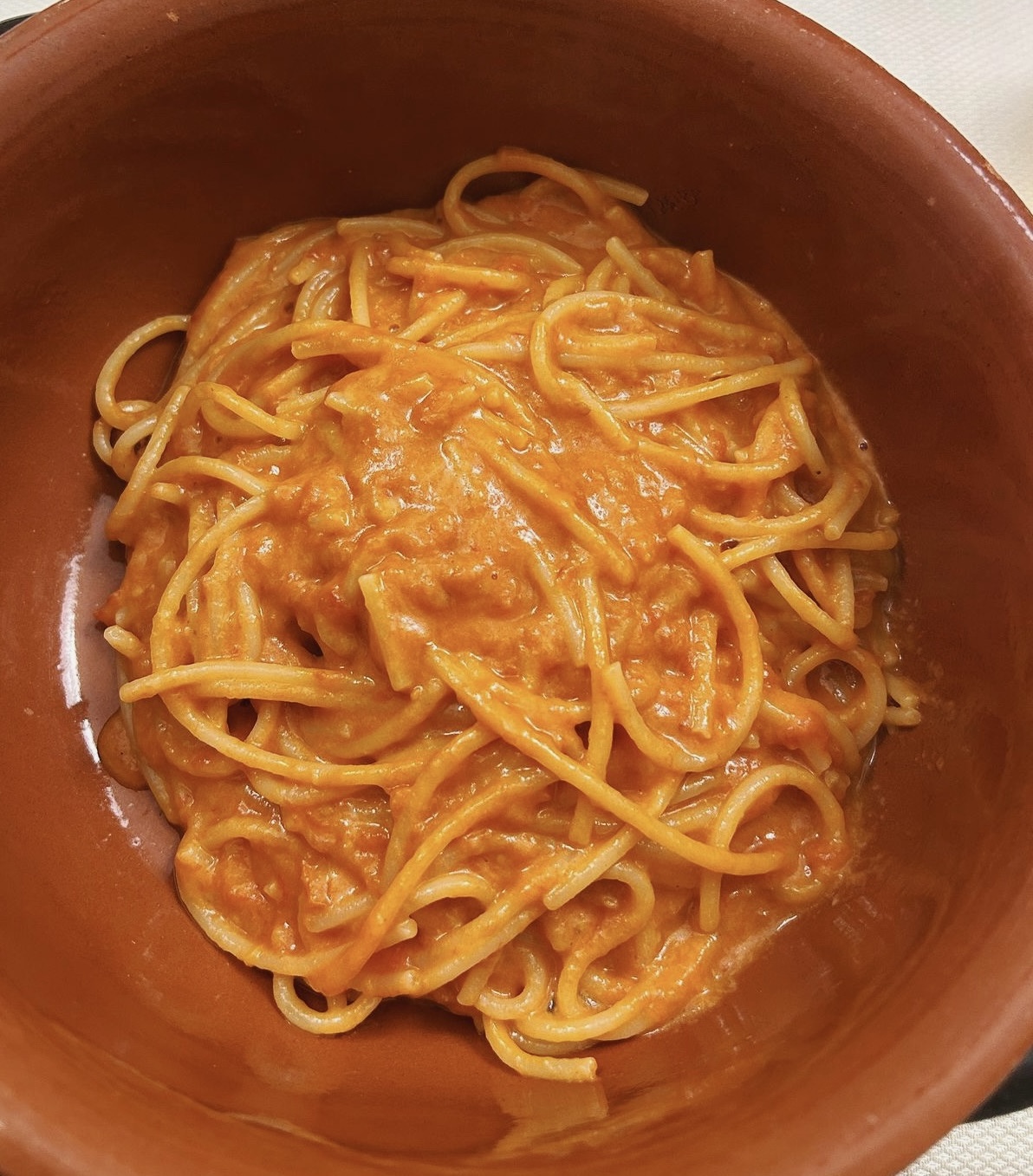
Busiate Cu L’Agghia at Cantina Siciliana
Trapani, Sicily
Made with just semolina and water, two tubes of pasta wind around each other in this spiraled shape, resembling an old telephone cord or double-helix DNA. The name comes from how the corkscrew shape was made, either around a “buso”, a knitting needle for wool and cotton, or “busa”, the grass stem used by Mediterranean farmers to tie sheaves of wheat. Cu L’Agghia, in local dialect, means the shape is served with pesto alla trapanese, a coarse, fragrant, and acidic counterpart to Liguria’s beloved version. Here, almonds are subbed for pine nuts, and tomatoes are thrown into the mix. Cantina Siciliana, owned by unashamedly restless and creative duo Pino Maggiore and Hajer Haissi, is known across Italy as the spot for Trapanese cuisine and serves a perfectly-chewy busiate with a generous amount of the garlicky, tomatoey, and nutty pesto.

Photo by Carlotta Panza
Tortellini Tradizionali in Brodo di Cappone at Trattoria di Via Serra
Bologna, Emilia-Romagna
The tortellini in brodo at Trattoria di Via Serra is the Platonic ideal of the plate. The tortellini are neither too big, nor too small, with a nice amount of bite to boot, while the ratio of broth to tortellini is perfect; you’ll have a tortellino for every spoonful, without ending up with a whole lot of empty liquid at the end. Though we actually wouldn’t complain if we did, because the broth, made from capon, is deeply, deeply flavorful without verging into “too salty” territory. This 35-seat trattoria has light-blue checked tablecloths, though you won’t be able to let a drop of sauce fall to waste on them, and is one of the few places in Bologna to have earned the Slow Food award. Owners Flavius and Thomas emphasize local ingredients, partnering with high-quality Emilian producers such as Caseificio Rosola di Zocca for cheese, the Azienda Agricola Mesini for organic flour, and Macellaio Ezio for meat. Honorable mention goest to the Gramigna al torchio con ragù di salsiccia montanara
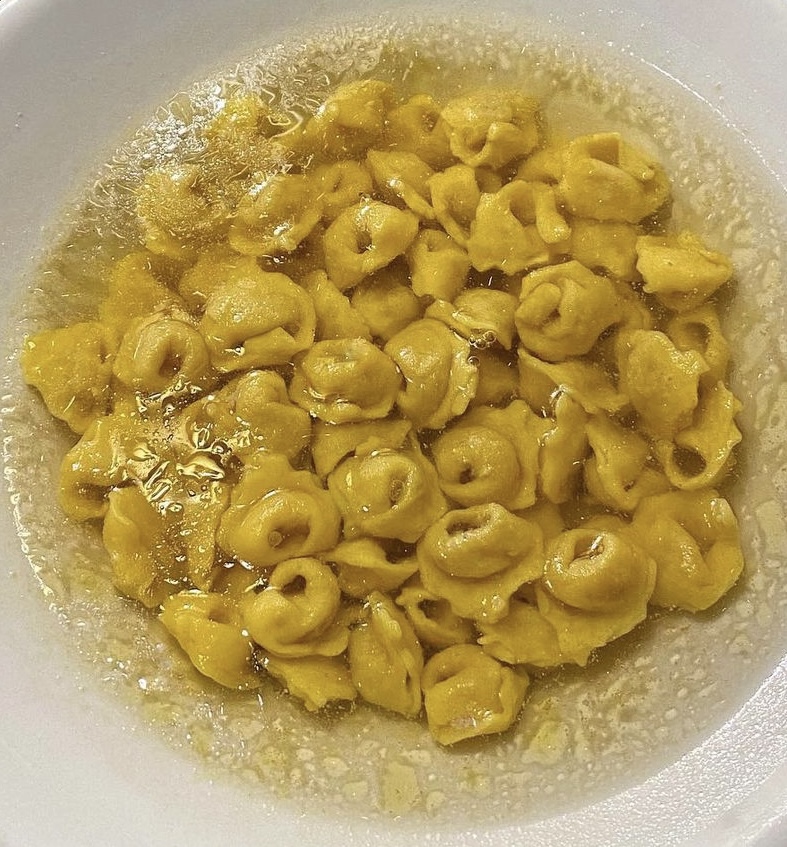
Spaghetto allo Spruzzo di Balena at Spiaggia dell’Arenella
Isola del Giglio, Tuscany
A simple dish in a simple setting. This spaghetti of tomato, anchovies, parsley, and breadcrumbs is served on a huge silver tray, while you sit on the plastic chairs of the Arenella bagno with your feet in the sand. Ordering directly at the bar counter often involves fighting through a hungry crowd, but, trust us, it’s worth it. This is one of those places to live estate italiana at its finest and that proves island life really is just all that.
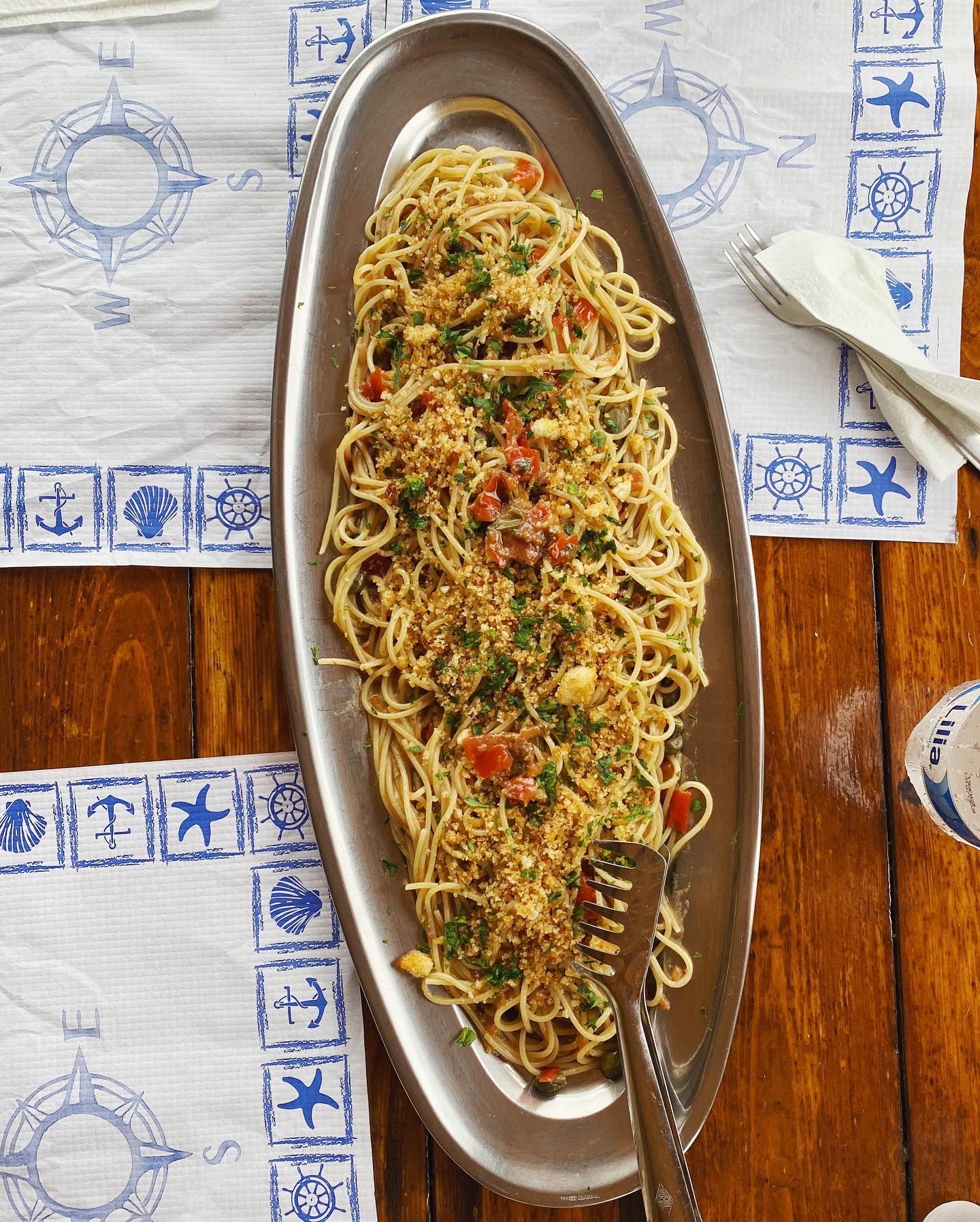
Penne alla Bettola at Alla Vecchia Bettola
Florence, Tuscany
We love this place for the chaotic, communal tables, endless jugs of Chianti, and, most of all, the penne alla bettola, a riff on pasta alla vodka glorified with a hearty dose of tomato. It’s got a cult following in Florence, among both visitors and locals, and you’ll find plenty of imitations–but it’s best here at the source, alongside the rest of the rustic, home-cooked offerings. Don’t miss the fried artichokes to start and the torta alle mele to end.

Cappelletti ripieni di lingua con cipolla di Tropea ed erbe aromatiche at Osteria Iotto
Campagnano Romano, Lazio
Though the menu at this spot in a sleepy town 40 minutes outside of the capital changes daily, these sophisticated cappelletti–filled with veal tongue, caramelized onions, and aromatic herbs–were such a fan favorite that Chef Marco has made them an evergreen on the menu. (That said, if you don’t find the stuffed pasta when you visit, you can’t go wrong with any other choice, made with produce as local to the town as the family.) Check their social media for their frequent collabs and pop-up dinners, and don’t skip out on their insane selection of natural wine. Honorable mention goes to the fusilli with arugula pesto, lemon, and piccadilly tomatoes.
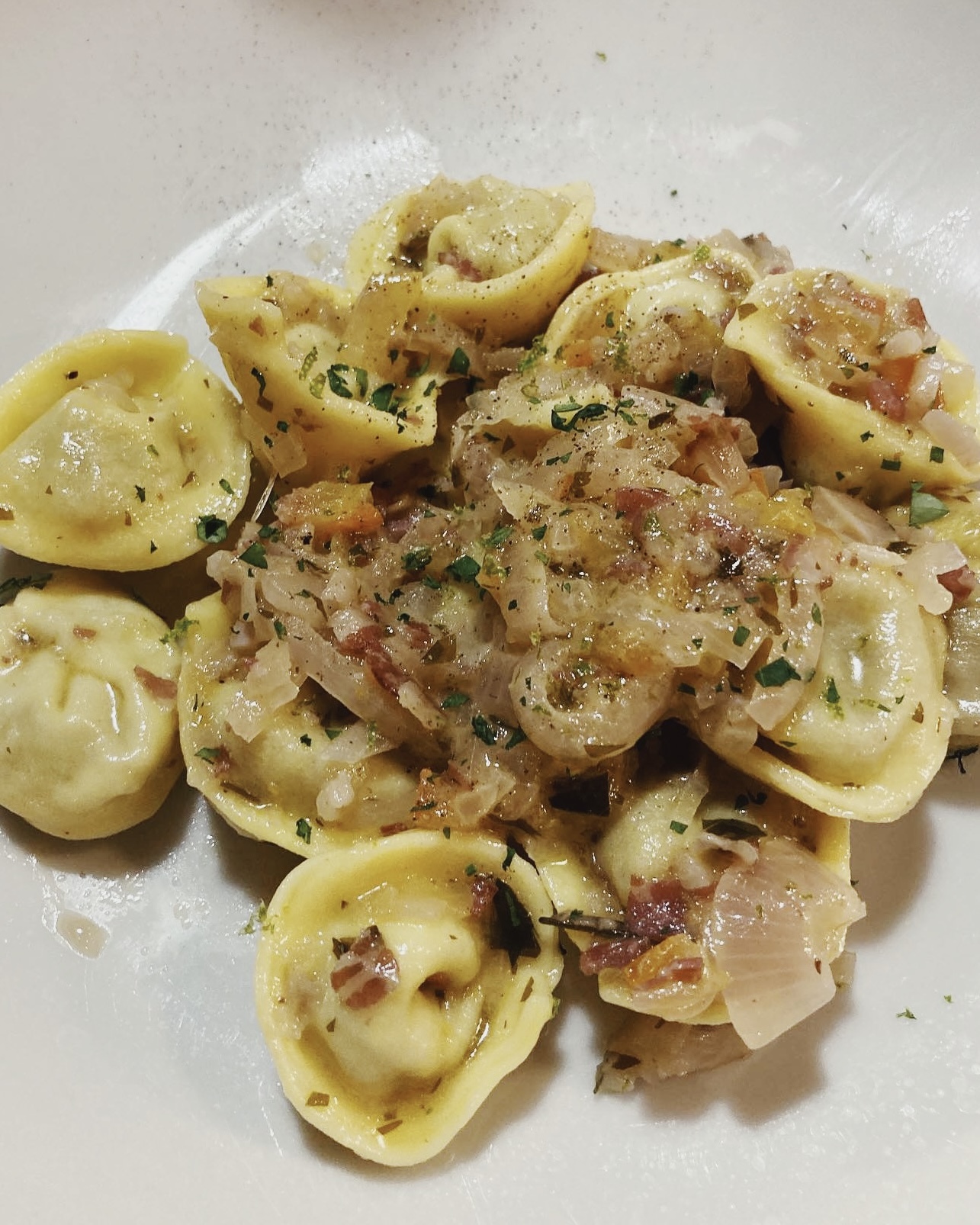
Tortelli di Zucca at Trattoria Ai Due Platani
Parma, Emilia-Romagna
Thanks to a healthy dose of butter, pumpkin puree, and paper-thin pasta, these plump parcels absolutely melt in your mouth. The plate is a more delicate choice compared to the meat-heavy primi of the region–we love an underdog story!–though it certainly doesn’t skimp on flavor. Light, light pasta gives way for the filling to shine, while the sweetness of the pumpkin is tempered by salty (local!) Parmigiano. Five minutes from the center of Parma, this little haven of Emilian cuisine was born in the 1920s and named after the tradition in Schianchi that families were given two plants when their child was born. For dessert, don’t skip the gelato alla crema, made on the spot (with caramelized hazelnuts and zabaglione liqueur if you so desire) and served from a dripping tower of the stuff. Reserve in advance.
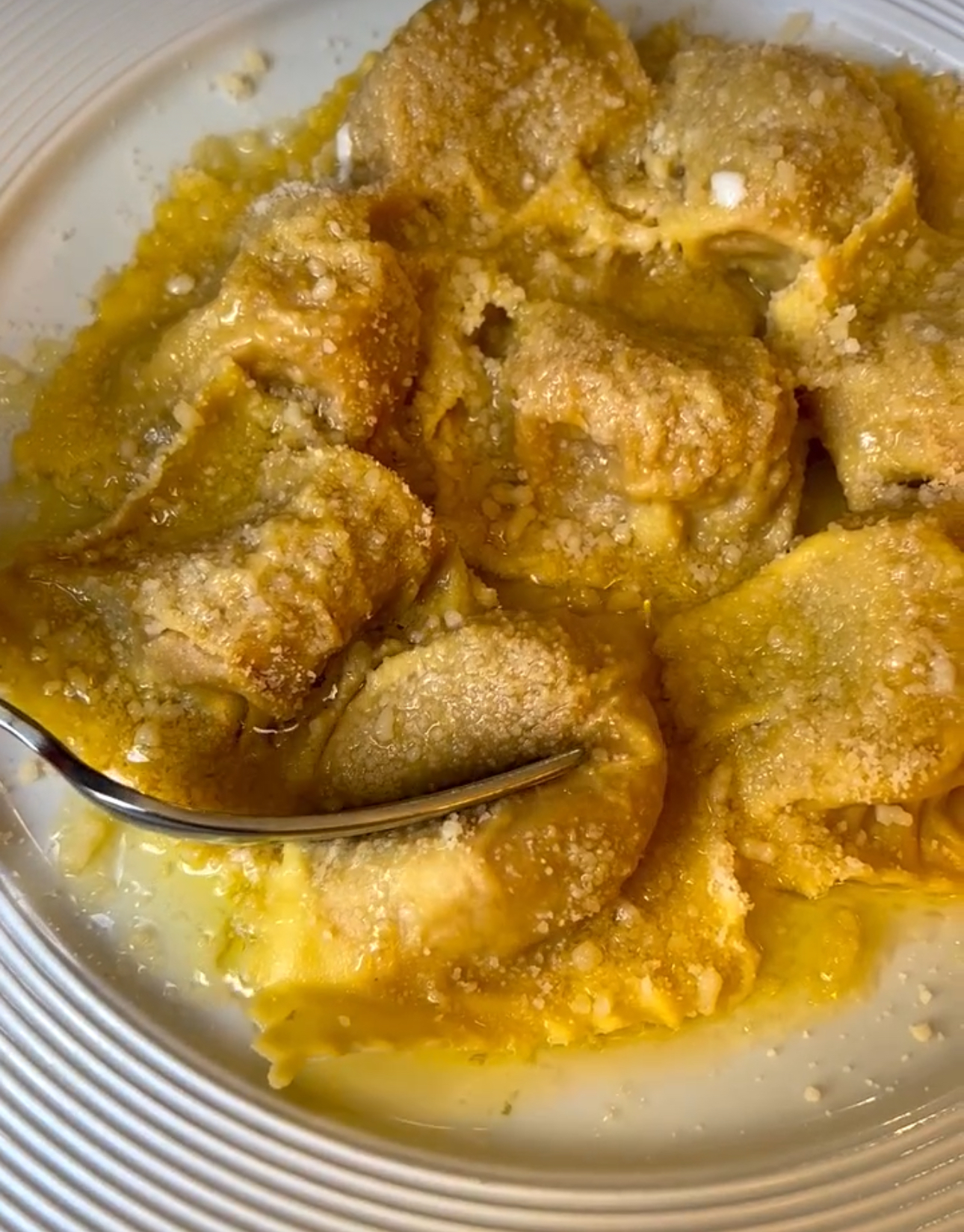
Rigatoni all’Amatriciana at Cesare Al Pellegrino
Rome, Lazio
There are many veritable contenders for the best of Rome’s holy pasta trinity–cacio e pepe, carbonara, and amatriciana–but, of the latter, we think you can’t do better than Cesare Al Pellegrino. This is the real deal, made according to the traditional recipe with fantastic local ingredients, and comes the closest to the ones we’ve eaten at home. The amatriciana can be requested with bucatini, but we prefer the rigatoni. The spot is the new location of the famed Trattoria Da Cesare al Casaletto, and it’s like stepping back in time to a bygone era of Roman dining where you’ll find elevated versions of the typical Roman dishes found on the menu of their Monteverde counterpart. Honorable mention goes to their rigatoni con sugo degli involtini.
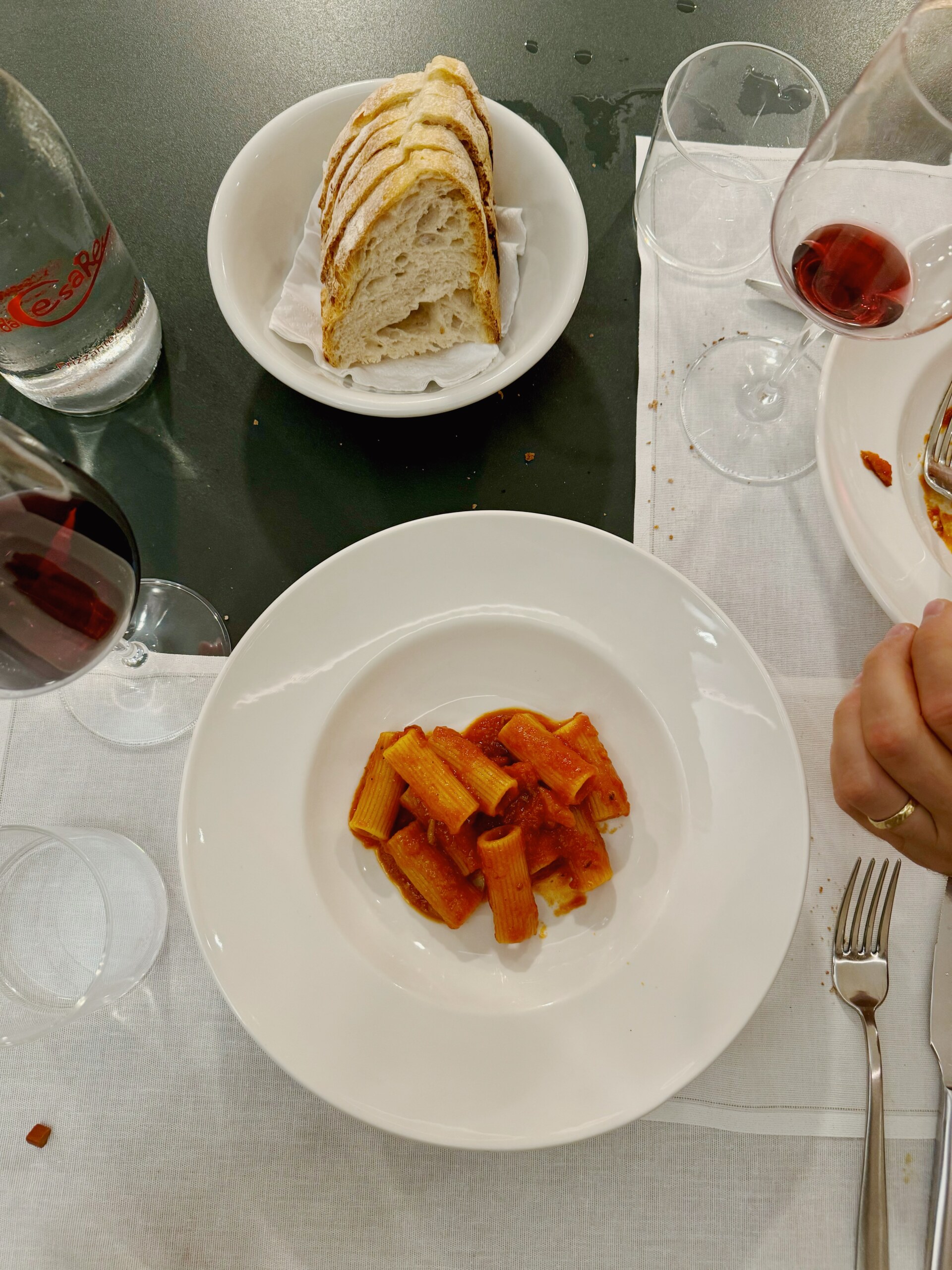
Pici all’Aglione at Trattoria la Torre
Siena, Tuscany
It’s time to acquaint yourself with the aglione, a massively bulbous variety of garlic native to the Valdichiana region of Tuscany. Much more delicate in flavor than normal garlic–it doesn’t have that same harsh bite–aglione is most often used in pici all’aglione, a tomatoey sauce perfumed with the allium atop the region’s thick, hand-rolled noodles. The superlative version at Trattoria la Torre is abundant, with a sauce that’s heavy on the namesake garlic and silkily coats the pasta strands. Honorable mention goes to the pappardelle al ragù.
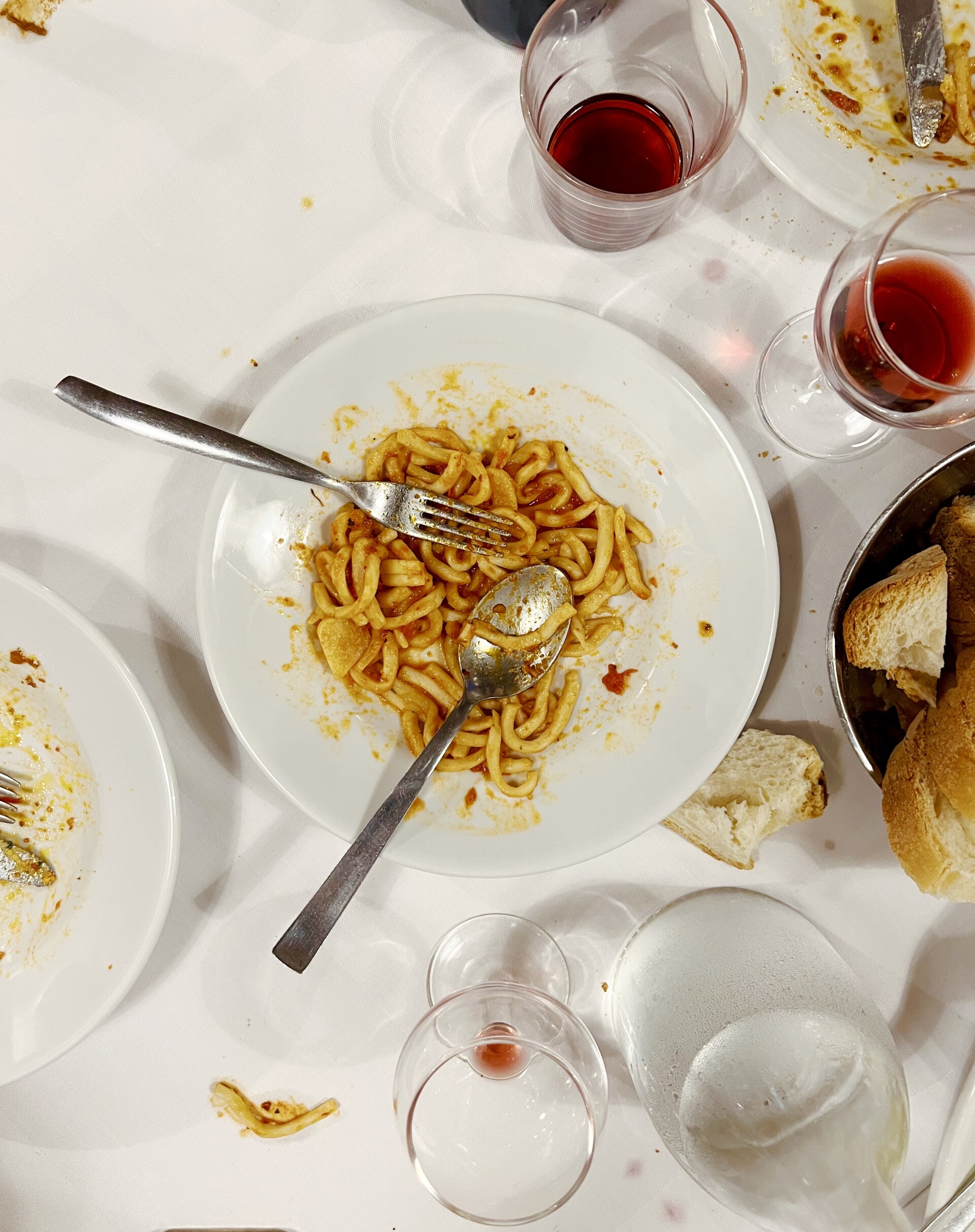
Tagliatelle delle Tradizione al Ragù at La Sangiovesa
Sant’Arcangelo di Romagna, Emilia-Romagna
There are plenty of fantastic plates of pasta al ragù (what non-Italians know as “bolognese”) in its birthplace of Emilia-Romagna, but this one stands out, not just for the absolute perfection of both pasta and sauce, but for the place. La Sangiovesa was founded by the Maggioli family, who, aided by the imagination and flair of Tonino Guerra (poet, Fellini screenwriter, and friend), created a bastion of Romagnolità. They unearthed the ancient remains, caves, and rooms of the Nadiani palace in the heart of Sant’Arcangelo di Romagna and transformed them into this restaurant-osteria.
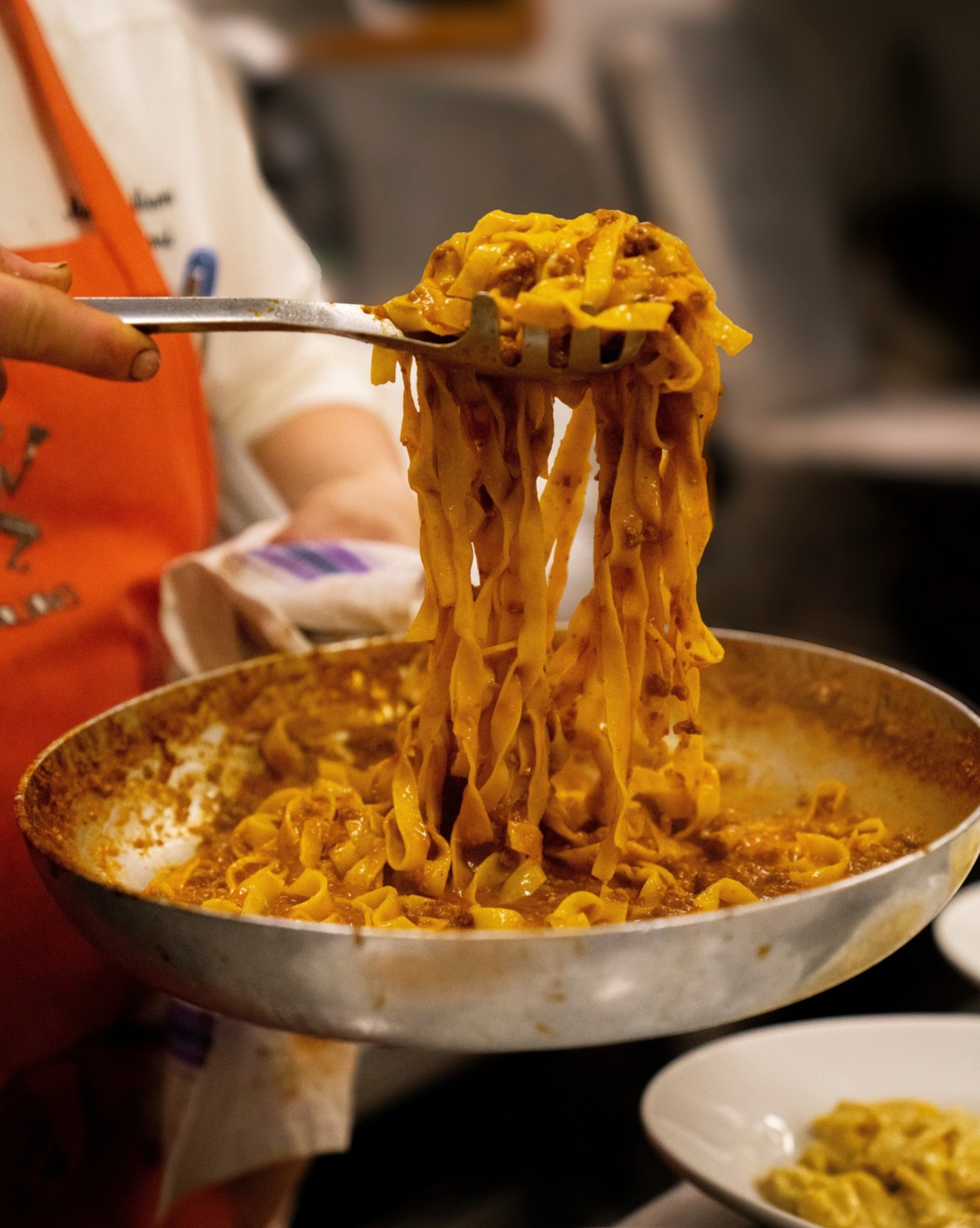
Mandilli de Sea at Trattoria Settembrin
Carasco, Liguria
Long, wide ribbons of thin pasta are dressed here in the most luscious pesto you’ll ever taste–served, in the traditional way, with potatoes and green beans. (They do justice, as well, to Liguria’s other sauce: the little-lauded salsa di noci, which tops pansotti di magro.) Forty five kilometers outside Genova, Settembrin has 150 years of experience in Ligurian tradition, so you better bet they’re doing something right. Open from 6 AM to 10 PM, the bar on the main floor looks like a place where director Wes Andeson could film a scene.
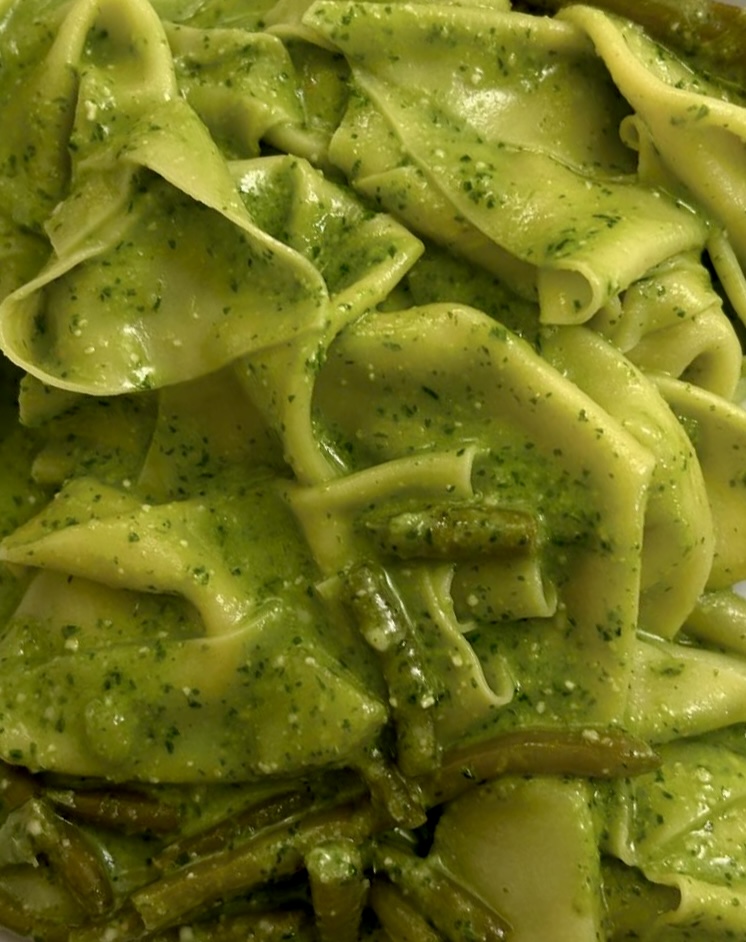
Tortellini Alla Panna D’affioramento Mirasole at Antica Osteria del Mirasole
San Giovanni in Persiceto, Emilia-Romagna
You’ll need a car to get to Antica Osteria del Mirasole, but it’s well worth the drive. (If you need to take a plane to get to Italy first, it’s well worth the flight.) Their plate of tortellini alla panna d’affioramento is the stuff of food porn. Franco Cimini may be Abruzzese but he’s certainly done wonders for Emilian cuisine: these tortellini–filled with pork loin, Mortadella, Prosciutto di Parma, and Parmigiano Reggiano–swim in fresh cream from their dairy farm Caseificio S.Angelo. The cream comes from the same milk that’s used to make their Parmigiano, which is left to rest overnight to develop this slightly acidic cream. If you time your road trip with an evening arrival, you can even stay the night in the adjoining inn. (Another honorable mention goes to their ragù di cortile, served atop fresh tagliatelle.)
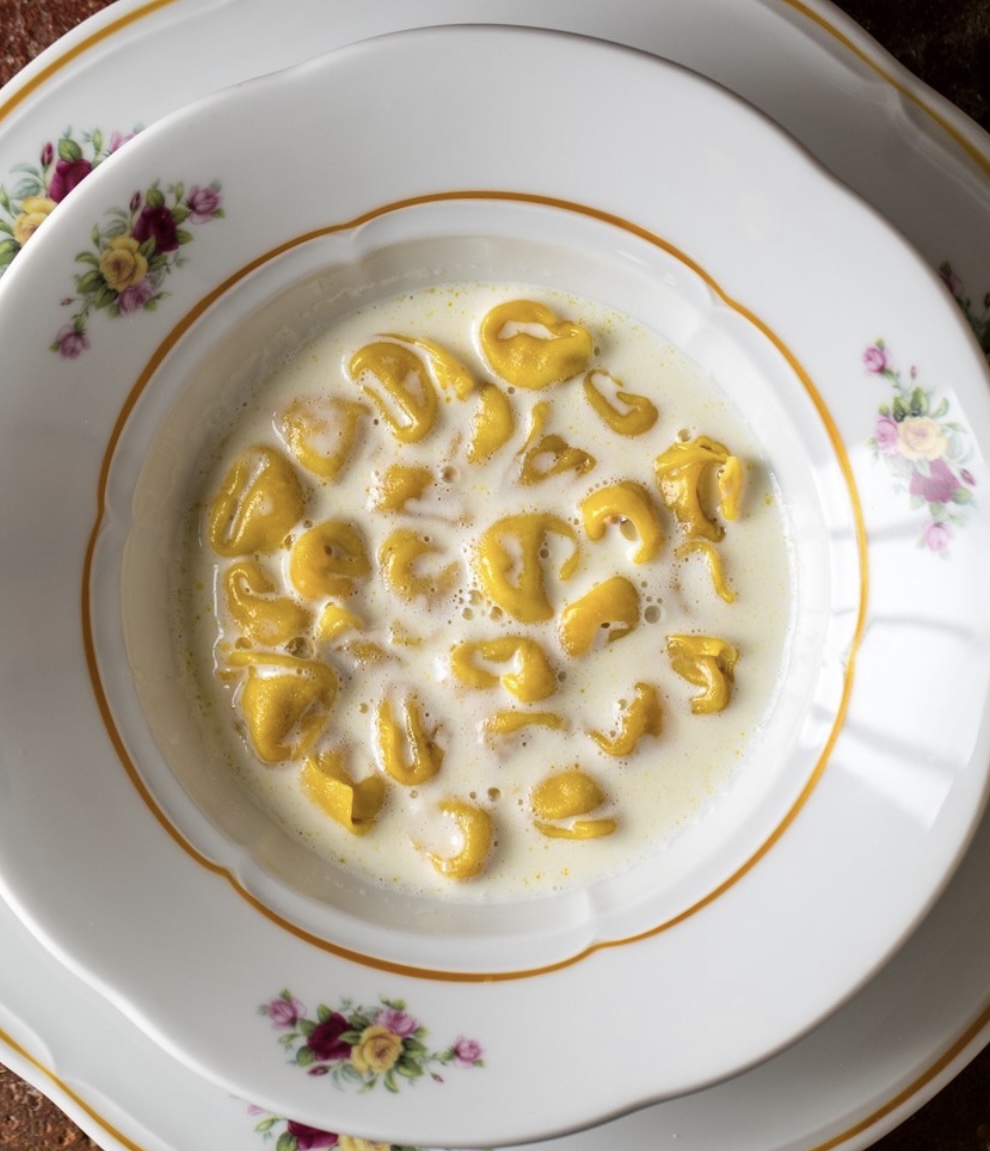
Tortellini Alla Panna D'affioramento at Osteria Mirasole
Tagliolini Vongole, Gamberi, e Bottarga at Le Mani in Pasta
Rome, Lazio
You can’t go wrong at this seafood-focused spot in Trastevere–we love the artichokes with squid and the carpaccio di spigola al tartufo–but the tagliolini vongole, gamberi, e bottarga is a revelation. The pasta itself absorbs some of the seafoody sauce, and the bottarga, rather than the usual grating, comes in abundant shavings–though it doesn’t overshadow the delicate flavor of the clams nor the light sweetness of the shrimp. When in season, the tagliolini al tartufo is another must order.
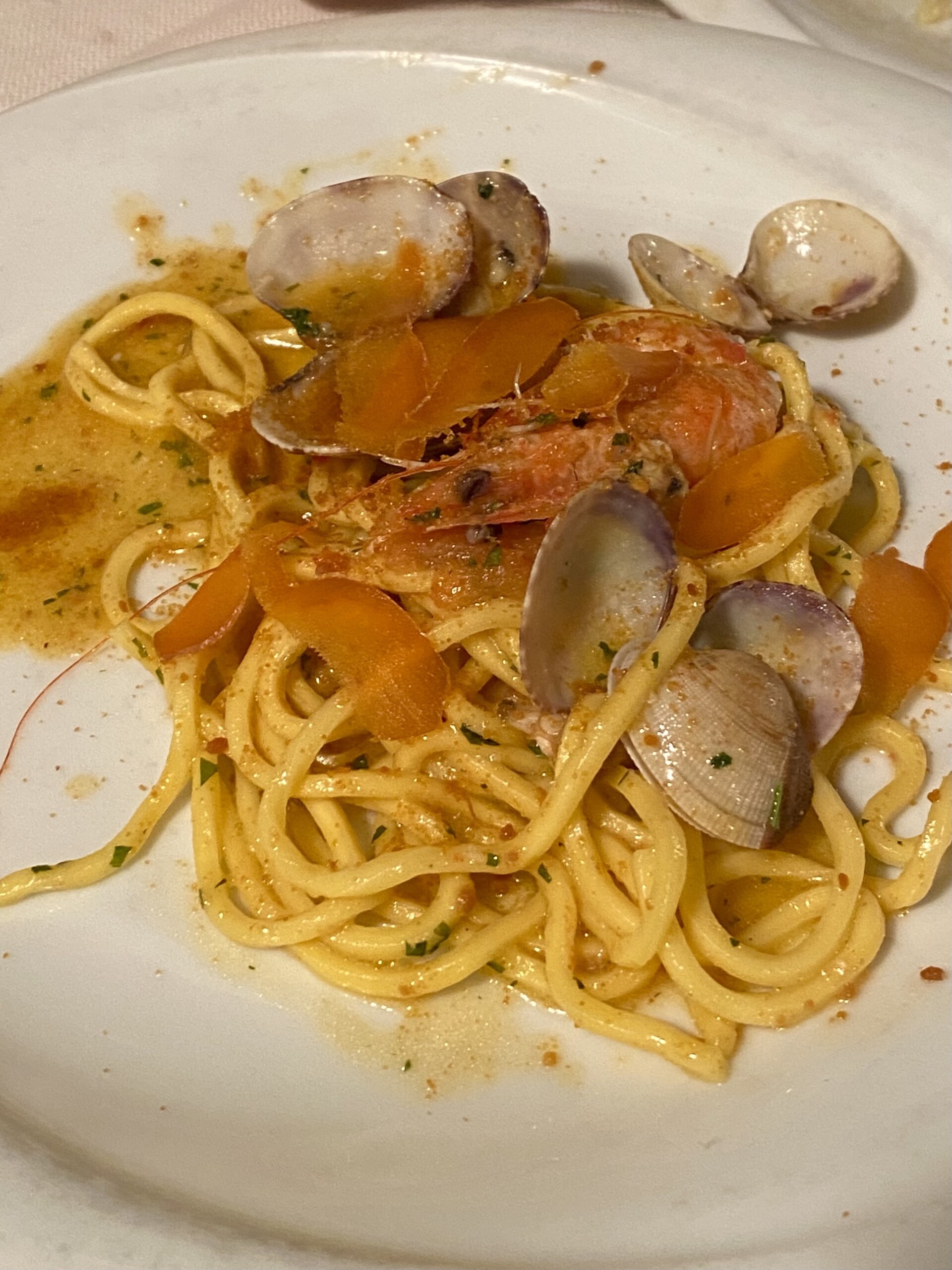
Spaghetti alla Nerano at Lo Scoglio da Tommaso
Nerano, Campania
The dreamiest, summeriest pasta, spaghetti alla nerano is just spaghetti, fried zucchini, cheese, and basil. But it’s one of those dishes that is more than the sum of its parts. Originating right in the small bay of Nerano, a few different styles can be made depending on the cheese–provolone, Parmigiano, or pecorino–but for us (and Stanley Tucci!), the superlative version can be found at family-owned Lo Scoglio da Tommaso. Their true secret is la terra, when Peppino–the grandfather of the sibling trio that currently runs the restaurant–brings buckets of ripe zucchini and basil from their abundant plot of land every morning. But what really makes it great is il mare, which perfumes the dish as you twirl forkfuls on their terrace right over the water. (You can find their recipe here, courtesy of co-owner/family member Antonia De Simone.)
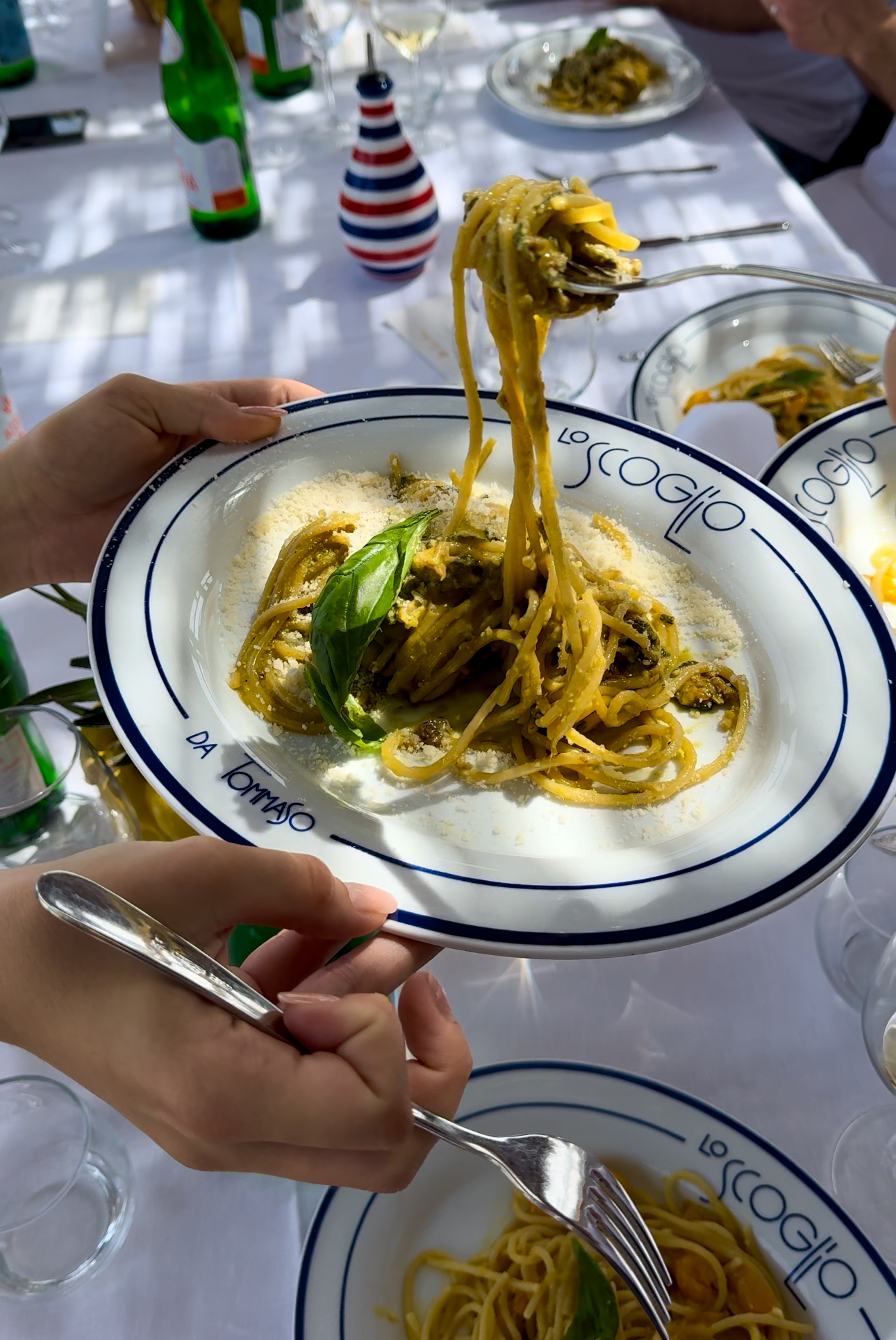
Tagliolini al Ragù di Salsiccia at Magazzino 52
Turin, Piedmont
This tomato-less ragù made of sausage, veal sweetbreads, rabbit liver, and thyme puts any ragù alla bolognese to shame. The fats of the various meats meld together to create the most unctuous pasta coater we’ve ever tried. Opened by a team of three friends united by a passion for wine and good food, Magazzino 52 has just a few quaint tables amidst stacked shelves of purchasable wine. You can treat their Piedmontese-inspired dishes as a build-your-own tasting menu, as dishes are priced out according to quantity ordered. Their wine list is equally impressive, with over 1,000 labels mainly from Piedmont, Tuscany, Bordeaux, Rhone, and Champagne.
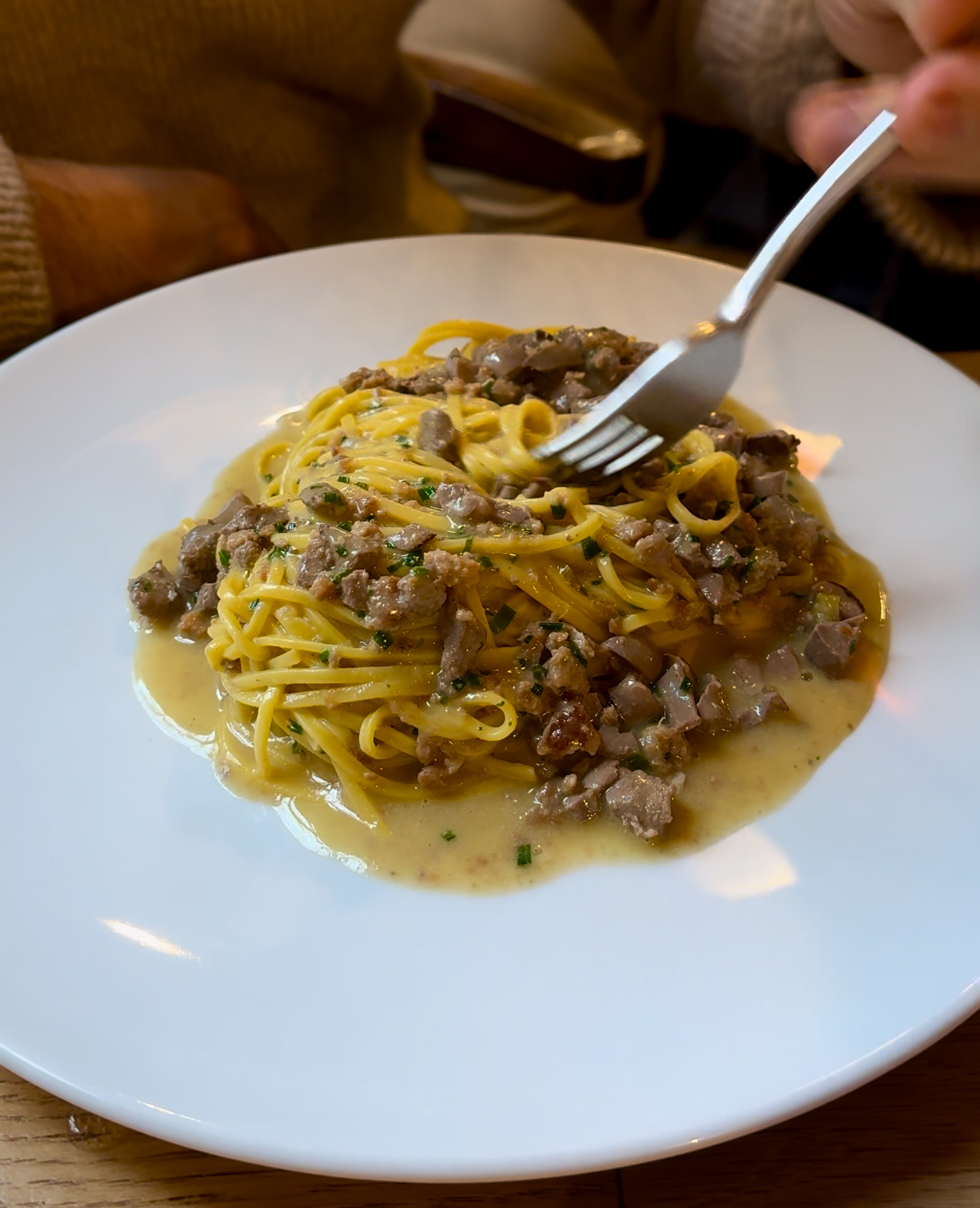
Ravioli di Friggione at Amerigo
Savigno, Emilia-Romagna
An underrated offering of Bologna’s primi, the original recipe of these ravioli, stuffed with onions and tomatoes, is preserved at the Chamber of Commerce of Bologna. Here at Amerigo, Medicina golden onions are browned and cooked with tomato paste and peeled tomatoes for two hours until reaching a thick, punchy paste, a dollop of which is placed inside each triangular raviolo. This institution, open since 1934, has one Michelin star–which you might not even realize since the cuisine is exceptionally comforting and traditional, the restaurant so cozy, and the portions actually satisfying. Local, seasonal dishes each feature the year in which they were first added to their menu, and after ordering, you’ll realize why they’ve been staples for so long.
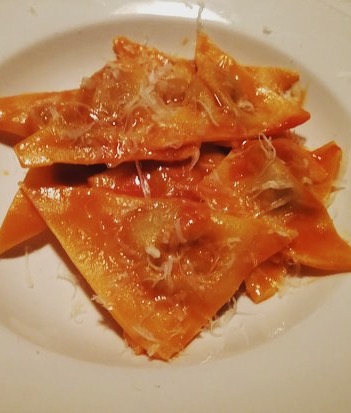
Pappardelle con Sugo D’Anatra at Vini E Vecchi Sapori
Florence, Tuscany
Small and tucked in an alley behind Piazza Signoria, Vini E Vecchi Sapori serves traditional food accompanied by non-traditional music (think top 40 hits) and a reverence for Madonna–no, not Mary, but the pop singer of “Like a Prayer” fame. We couldn’t decide between the pici al ragù and the pappardelle con sugo d’anatra, but ultimately landed on the latter for the long, eggy ribbons of pasta and the slow-cooked duck sauce that spends hours patiently simmering.
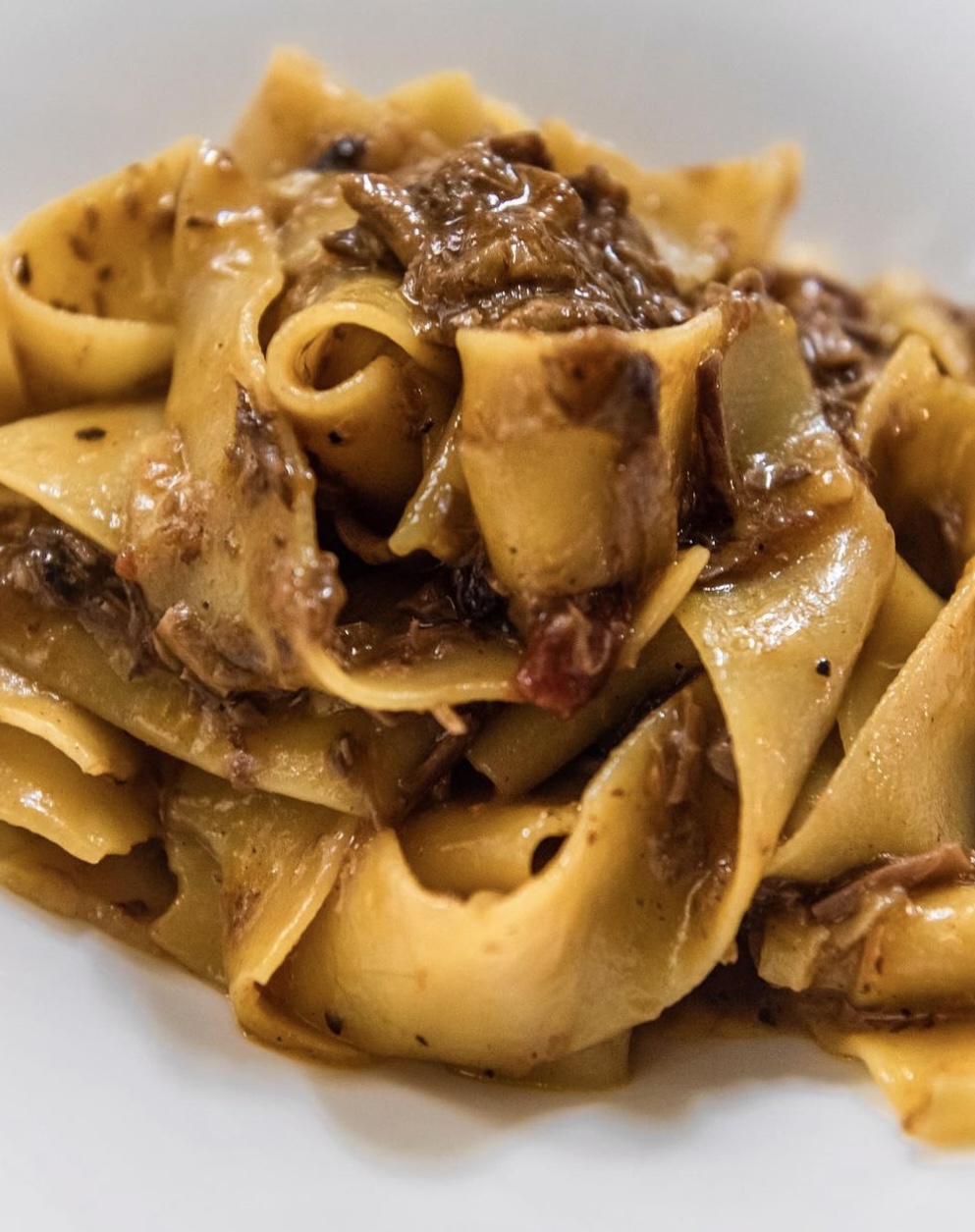
Tajarin al Ragù at Osteria da Gemma
Roddino, Piedmont
It’s one of the most well-known restaurants in Piedmont, and Gemma one of the best-known chefs (though she’d tell you she’s not a chef, but a casalinga, or home cook), and yet the four-course fixed menu won’t run you much more than 30 something euros. The tajarin here are made the traditional way: hand rolled and cut and with 40 yolks per kilo of flour (which is what gives the noodles their rich taste and bright yellow color). The best tajarin, like those at Gemma–which is why we agree with NYT’s choice here–will be incredibly soft and so paper thin that the noodles are practically see-through and topped with a light ragù; here the sauce is made with veal. (You’ve likely had this shape of pasta under the guise of tagliolini. The shape–and dialectal pronunciation of tagliolini–hails from the rolling, Barolo-producing hills of Piedmont’s Langhe region.)
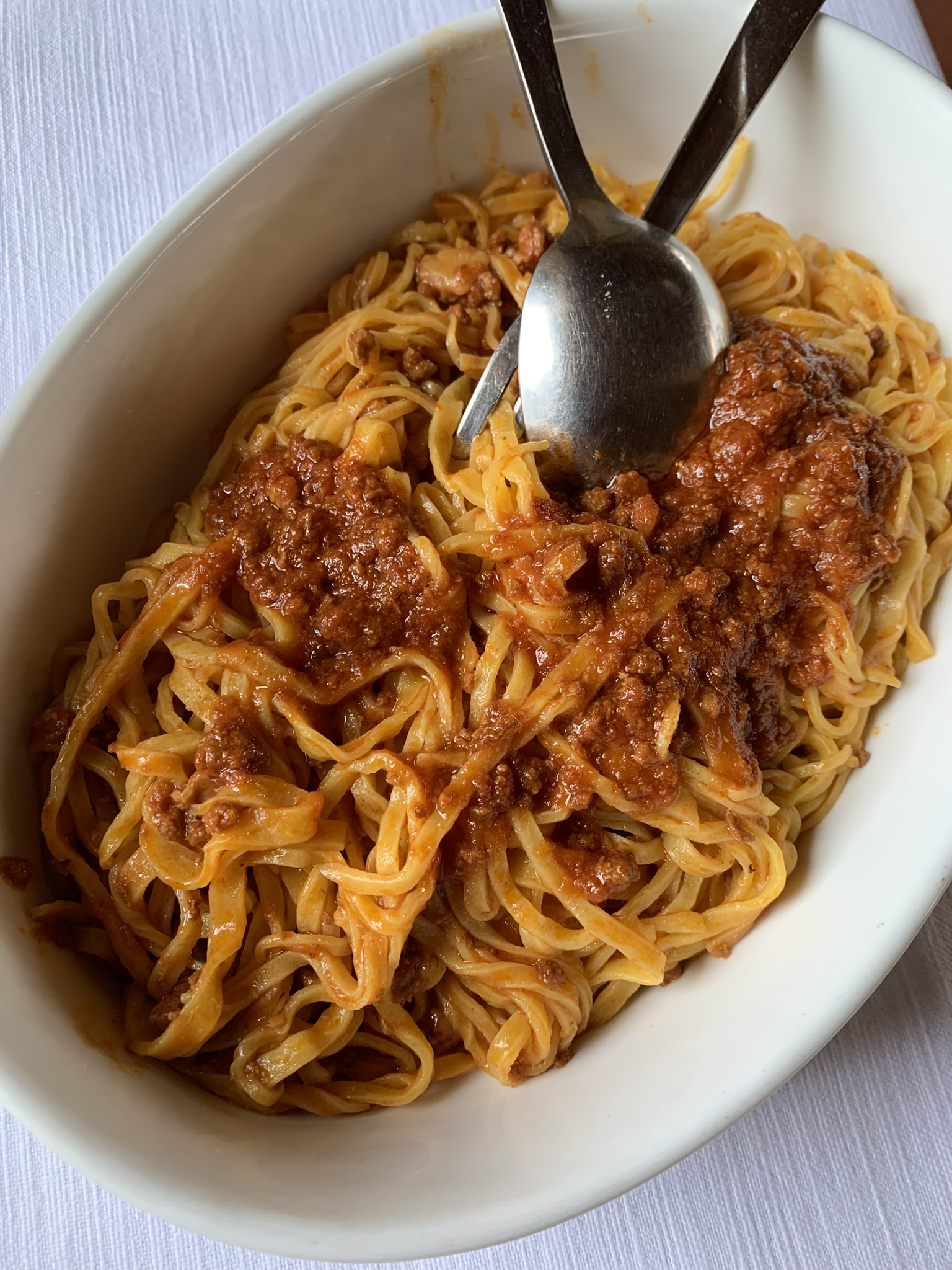
Tajarin with salsiccia di bra ragù; Photo by Carlotta Panza
La Spaghettata di Mezzanotte A Casa
Everywhere, Italy
Last, but certainly not least–in fact, maybe the best of the bunch?–there’s just nothing like a pasta fatta a casa (made at home). And we’re not talking about someone’s nonna rolling out the stuff fresh and laboriously cooking a sauce for 5, 6, 749 hours. We’re talking about la spaghettata di mezzanotte (midnight spaghetti), made among friends, after a night out, with the most minimal of pantry ingredients and a box of whatever dried pasta is on hand. There is no specific recipe to follow, there is no right or wrong, there are no strict methodological rules, and there are no family cookbooks handed down from generation to generation. That said, the epitome of la spaghettata di mezzanotte is the simplest aglio, olio, e peperoncino (garlic, oil, and hot chili pepper); you’ll rarely find it in a restaurant, but it’s one of our all-time favorites when made at home (or a friend’s house).
